903.8 Freeway and Expressway Guide Signs: Difference between revisions
m →903.8.35.1 Guide Sign Distance. (MUTCD Section 2E.29a): Minor clarification, per Traffic |
m →903.8.25 Signing for Interchange Lane Drops (MUTCD Section 2E.20): Per Traffic (and the Highway Capacity Manual 2000), lane-add to lane-drop distances requiring this distance increased to 2500'. |
||
| Line 660: | Line 660: | ||
|} | |} | ||
'''Standard.''' Major guide signs for all lane drops at interchanges shall be mounted overhead. An EXIT ONLY panel shall be used for all interchange lane drops at which the through route is carried on the mainline and when a continuous lane is dropped at an interchange, and the lane being dropped is a minimum of | '''Standard.''' Major guide signs for all lane drops at interchanges shall be mounted overhead. An EXIT ONLY panel shall be used for all interchange lane drops at which the through route is carried on the mainline and when a continuous lane is dropped at an interchange, and the lane being dropped is a minimum of 2500 ft. in length from full lane width to the driving pavement exit gore point. | ||
'''Guidance.''' The EXIT ONLY (down arrow) (E3-3) panel should be used on all signing of lane drops on all Advance Guide signs for right exits and appropriate Exit Direction signs (see Figure 903.8.25). For lane drops on the left side, diagrammatic signing with the EXIT ONLY (E3-2) panel should be used without a down arrow for Advance Guide signs (see Figure 903.8.24.5). | '''Guidance.''' The EXIT ONLY (down arrow) (E3-3) panel should be used on all signing of lane drops on all Advance Guide signs for right exits and appropriate Exit Direction signs (see Figure 903.8.25). For lane drops on the left side, diagrammatic signing with the EXIT ONLY (E3-2) panel should be used without a down arrow for Advance Guide signs (see Figure 903.8.24.5). | ||
Revision as of 10:48, 19 January 2011

903.8.1 Scope of Freeway and Expressway Guide Sign Standards (MUTCD Section 2E.01)
Support. These standards provide a uniform and effective system of highway signing for high-volume, high-speed motor vehicle traffic on freeways and expressways. The requirements and specifications for expressway signing exceed those for conventional roads (see EPG 903.7), but are less than those for freeway signing. Since there are many geometric design variables to be found in existing roads, a signing concept commensurate with prevailing conditions is the primary consideration. Refer to EPG 903.19.13 for definitions of freeway and expressway.
Guide signs for freeways and expressways are primarily identified by the name of the sign rather than by an assigned sign code. Guidelines for the design of guide signs for freeways and expressways are provided in Sign Detail and Chapter 8 (Design Guidelines) of the federal Standard Highway Signs book (see EPG 903.19.11).
Standard. The standards prescribed herein for freeway or expressway guide signing shall apply to any highway that meets the definition of such facilities.
903.8.2 Freeway and Expressway Signing Principles (MUTCD Section 2E.02)
Support. The development of a signing system for freeways and expressways is approached on the premise that the signing is primarily for the benefit and direction of travelers who are not familiar with the route or area. The signing furnishes travelers with clear instructions for orderly progress to their destinations. Sign installations are an integral part of the facility and, as such, are best planned concurrently with the development of highway location and geometric design. For optimal results, plans for signing are analyzed during the earliest stages of preliminary design and details are correlated as final design is developed. The excessive signing found on many major highways usually is the result of using a multitude of signs that are too small and that are poorly designed and placed to accomplish the intended purpose.
Freeway and expressway signing should be considered and developed as a planned system of installations. An engineering study is sometimes necessary for proper solution of the problems of many individual locations, but, in addition, consideration of an entire route is necessary.
Guidance. Travelers should be guided with consistent signing on the approaches to interchanges when they drive from one state to another and when driving through rural or urban areas. Because geographical, geometric and operating factors regularly create significant differences between urban and rural conditions, the signing should take these conditions into account. Guide signs on freeways and expressways should serve distinct functions as follows:
A. Give directions to destinations, or to streets or highway routes, at intersections or interchanges;
B. Furnish advance notice of the approach to intersections or interchanges;
C. Direct travelers into appropriate lanes in advance of diverging or merging movements;
D. Identify routes and directions on those routes;
E. Show distances to destinations;
F. Indicate access to general motorist services, rest, scenic and recreational areas; and
G. Provide other information of value to the traveler.
903.8.3 General Design (MUTCD Section 2E.03)
Support. Signs are designed so that they are legible to travelers approaching them and readable in time to permit proper responses. Desired design characteristics include: (a) long visibility distances, (b) large lettering and symbols and (c) short legends for quick comprehension.
Standard. Standard shapes and colors shall be used so that travelers can promptly recognize traffic signs.
903.8.4 Roadway Signing Categories (MUTCD Section 2E.03a)
Support. Reserved for future use.
903.8.5 Guide Sign Colors (MUTCD Section 2E.04)

Standard. Guide signs on freeways and expressways, except as noted herein, shall have white letters, symbols and borders on a green background.
Support. In the case of “EXIT ONLY” panels or other legends that require extra emphasis, the legend shall be black on fluorescent yellow background.
Color requirements for route signs and trailblazers, signs with blank-out or changeable messages, signs for services, rest areas, park and recreational areas and for certain miscellaneous signs are specified in the individual sections dealing with the particular sign or sign group.
903.8.6 Retroreflection or Illumination (MUTCD Section 2E.05)
Standard. Letters, numerals, symbols, and borders of all guide signs shall be retroreflectorized. The background of all guide signs that are not independently illuminated shall be retroreflective.
Support. Where there is no serious interference from extraneous light sources, retroreflectorized ground-mounted signs usually provide adequate nighttime visibility.
On freeways and expressways where much driving at night is done with low-beam headlights, the amount of headlight illumination incident to an overhead sign display is relatively small.
Guidance. Overhead sign installations should be illuminated unless an engineering study shows that retroreflectorization alone will perform effectively. The type of illumination chosen should provide effective and reasonably uniform illumination of the sign face and message.
903.8.7 Urban Signing Characteristics (MUTCD Section 2E.06)
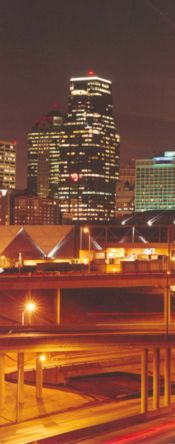
Support. Urban conditions are characterized not so much by city limits or other arbitrary boundaries, as by the following features:
A. Mainline roadways with more than two lanes in each direction;
B. High traffic volumes on the through roadways;
C. High volumes of traffic entering and leaving interchanges;
D. Interchanges closely spaced;
E. Roadway and interchange lighting;
F. Three or more interchanges serving the major city;
G. A loop, circumferential or spur serving a sizable portion of the urban population; and
H. Visual clutter from roadside development.
Operating conditions and road geometrics on urban freeways and expressways usually make special sign treatments desirable, including:
A. Use of Interchange Sequence signs;
B. Use of sign spreading to the maximum extent possible (see EPG 903.8.11);
C. Elimination of service signing (see General Service Signs);
D. Reduction to a minimum of post-interchange signs (see Post-Interchange Signs);
E. Display of advance signs at distances closer to the interchange, with appropriate adjustments in the legend (see Advance Guide Signs);
F. Use of overhead signs on roadway structures and independent sign supports (see Overhead Sign Installations);
G. Use of diagrammatic signs in advance of intersections and interchanges; and
H. Frequent use of street names as the principal message in guide signs.
Lower speeds that are often characteristic of urban operations do not justify lower signing standards. Typical traffic patterns are more complex for the traveler to negotiate and large, easy-to-read legends are, therefore, just as necessary as on rural highways.
903.8.8 Rural Signing Characteristics (MUTCD Section 2E.07)
Support. Rural areas ordinarily have greater distances between interchanges that permit adequate spacing for the sequences of signs on the approach to and departure from each interchange. However, the absence of traffic in adjoining lanes and on entering or exiting ramps often adds monotony or inattention to rural driving. This increases the importance of signs that call for decisions or actions.
Guidance. Where there are long distances between interchanges and the alignment is relatively unchanging, signs should be positioned for their best effect on travelers. The tendency to group all signing in the immediate vicinity of rural interchanges should be avoided by considering the entire route in the development of sign plans. Extra effort should be given to the placement of signs at natural target locations to command the attention of the traveler, particularly when the message requires an action by the traveler.
903.8.9 Signing of Named Highways (MUTCD Section 2E.08)
Support. Refer to EPG 903.7.70.
903.8.10 Amount of Legend on Guide Signs (MUTCD Section 2E.09)
Guidance. No more than two destination names or street names should be shown on any Advance Guide sign or Exit Direction sign. A city name and street name on the same sign should be avoided. Where two or three signs are placed on the same supports, destinations or names should be limited to one per sign, or to a total of three in the display. Signs should be designed with no more than five lines of copy, preferably only three or four. “Lines of Copy”, as used above includes an arrow or shield on a line by itself.
Option. Sign legends may include symbols, route numbers, arrows, cardinal directions and exit instructions.
903.8.11 Number of Signs at an Overhead Installation and Sign Spreading (MUTCD Section 2E.10)
Guidance. If overhead signs are warranted, as set forth in Overhead Sign Installation, the number of signs at these locations should be limited to only those essential in communicating pertinent destination information to the traveler. Exit Direction signs for a single exit and the Advance Guide signs should have only one panel with one or two destinations. Regulatory signs, such as speed limits, are not to be used in conjunction with overhead guide sign installations. Because travelers have limited time to read and comprehend sign messages, there is not to be more than three guide signs displayed at any one location either on the overhead structure or its support.
Option. At overhead locations, more than one sign may be installed to advise of a multiple exit condition at an interchange. If the roadway ramp or crossing roadway has complex or unusual geometrics, additional signs with confirming messages may be provided to properly guide the traveler.
Support. Sign spreading, illustrated by Figure 903.8.11, is where major overhead signs are spaced so that travelers are not overloaded with a group of signs at a single location
Guidance. Where overhead signing is used, sign spreading should be used at all single exit interchanges and to the extent possible at multi-exit interchanges. Sign spreading should be accomplished by using the following:
A. The Exit Direction sign should be the only sign used in the vicinity of the gore (other than the Gore sign). It should be located overhead near the theoretical gore and generally on an overhead sign support structure.
B. The Advance Guide sign to indicate the next interchange exit should be placed near the crossroad location. If the crossroad goes over the mainline, the Advance Guide sign should be placed on the overcrossing structure.
Standard. No more than three signs shall be placed on any truss for one direction of travel, preferably only two. Only guide signs shall be placed on a truss for one traffic direction.
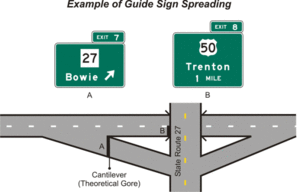
903.8.12 Route Confirmation/Pull-Through Signs (MUTCD Section 2E.11)
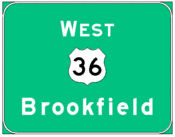 |
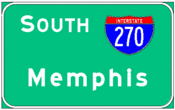 |
Support. Route confirmation and pull-through signs are overhead lane use signs intended for through traffic and may be used to assist motorists in advance of the divergence or convergence of two or more roadways. The sign may also be used to confirm the route and control city of a roadway after the interchange.
Most situations do not require pull-through signs. These signs are used at exit gores in conjunction with advance diagrammatic guide signs. Pull-through signs are eliminated when the sign spreading concept is applied.
Guidance. Pull-through signs should be used where the geometrics of an interchange may confuse travelers as to which is the through roadway or where additional route guidance is desired. Pull-through signs with down arrows should be used where the alignment of the through lanes is curved and the exit direction is straight ahead, where the number of through lanes is not readily evident and at multi-lane exits where there is a reduction in the number of through lanes.
Option. Route confirmation signing in advance of the interchange may include Type C lane control arrows over appropriate through lanes.
Standard. The overhead route confirmation sign shall include the appropriate route shield(s), the cardinal direction for each route and the control city or cities.
Route confirmation signing used downstream of diagrammatic signing shall include lane control arrows over all applicable lanes. Route confirmation signing used after the interchange shall not include lane control arrows.
903.8.13 Designation of Destinations (MUTCD Section 2E.12)
Standard. The direction of a freeway and the major destinations or control cities (see EPG 903.7.34) along it shall be clearly identified through the use of appropriate destination legends. Successive freeway guide signs shall provide continuity in destination names and consistency with available map information. At any decision point, a given destination shall be indicated by way of only one route.
Guidance. Control city legends should be used in the following situations along a freeway:
A. At interchanges between freeways;
B. At separation points of overlapping freeway routes;
C. On directional signs on intersecting routes, to guide traffic entering the freeway;
D. On Pull-Through signs; and
E. On the bottom line of post-interchange distance signs.
Support. Continuity of destination names is also useful on expressways serving long-distance or intrastate travel.
The determination of major destinations or control cities is important to the quality of service provided by the freeway. Control cities on freeway guide signs are selected by the State and are contained in the “List of Control Cities for Use in Guide Signs on Interstate Highways,” published and available from American Association of State and Highway Transportation Officials (see EPG 903.19.11.2 for AASHTO’s address), see Table 903.8.13.
Typically, interchanges between freeways and convention routes within an urban area identify the exit by the cross-street on the guide signing rather than using control points, control cities, or other community names.
Guidance. For interstates, post-interchange distance signs should contain at least two lines, preferably three with the nearest control city listed first if two cities are listed. The first line is generally the next destination reached by means of the next interchange. If no significant destinations exist between the next exit and the next control city, the second line should be omitted.
In a limited number of locations, the use of the name of a neighboring state or adjacent county might be more relevant. Use of these identifiers should be used sparingly and only if such a designation is in the best interest of the motorists in that region.
For urban interchanges of freeways and conventional routes the address block number of the cross-street should not be displayed unless multiple interchanges between the same two roadways exist.
For isolated rural interchanges, each interchange should be identified by either the name of its community or by the nearest control communities on the intersecting route. If the interchange is the junction of a freeway with a state-maintained route outside of any community, it is possible to use only the intersecting route shields as the identifier.
Destination signs with arrows at ramp terminals are not to contain distances (see Figure 903.13.15 Standard Diamond Interchange Signing).
Standard. The last, or in some cases the third line, shall be the next control city, or the control city used consistently throughout the route. If the intersecting road of freeway in an urban area is a state-maintained route, the appropriate route shield shall be used in addition to the street name or control communities displayed.
Destination signs shall not be used on roadways, which provide interchange sequence signing.
If used, Advance Destination signs shall be located a minimum of 200 ft. before an intersection or any ramp terminal. For three line signs, the destination going straight shall be listed first, with the arrow to the extreme left of the sign. The destination left shall be next with the arrow to the extreme left, and the third line with the destination right, with the arrow to the extreme right. The same order shall be used for two line destination signs.
Option. The second line, if used, may be any significant destination between the next exit and the next control city.
Advance Destination signs may be eliminated in urban areas where numerous destinations exist, numerous signs exist, or ground mounting space is limited.
A community within a predominantly rural area that is served by multiple interchanges may identify the interchanges using either the name of the cross-street, the name of the local community or the nearest control communities. If the isolated urban interchanges are identified by the cross street name, then the use of a D-3 series sign to identify a single community’s access via multiple exits would be allowed.
Table 903.8.13 Interstate Sign Control Cities

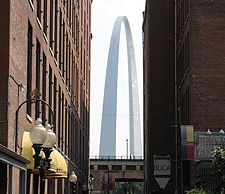

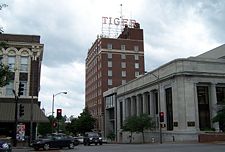
| Interstate | Cities |
|---|---|
| 29 | Kansas City, St. Joseph, Mound City, Council Bluffs, Sioux City, Fargo, Grand Forks, Winnipeg |
| 35 NB | Laredo, San Antonio, Austin, Waco, Dallas*Fort Worth, Oklahoma City, Wichita, Kansas City, Des Moines, Ames, Mason City, Albert Lea, St. Paul*Minneapolis, Duluth |
| 35 SB | Duluth, St. Paul*Minneapolis, Albert Lea, Mason City, Ames, Des Moines, Kansas City, Oklahoma City, Dallas*Fort Worth, Waco, Austin, San Antonio, Laredo |
| 44 | Wichita Falls, Lawton, Oklahoma City, Tulsa, Joplin, Springfield, Rolla, St. Louis |
| 55 | New Orleans, Hammond, McComb, Jackson, Grenada, Memphis, Blytheville, Sikeston, Cape Girardeau, St. Louis, Chicago |
| 57 NB | Sikeston, Charleston, Cairo, Chicago |
| 57 SB | Chicago, Cairo, Charleston, Sikeston, Memphis |
| 64 EB | St. Louis, Louisville, Lexington, Ashland, Huntington, Charleston, Beckley, Lewisburg, Lexington, Staunton, Richmond, Norfolk, Chesapeake |
| 64 WB | Richmond, Staunton, Lexington, Lewisburg, Beckley, Charleston, Huntington, Ashland, Lexington, Louisville, St. Louis, Wentzville |
| 70 EB | I-15, Grand Junction, Denver, Limon, Hays Salina, Topeka, Kansas City, Columbia, Wentzville, St. Louis, Indianapolis, Columbus, Wheeling, Washington (PA), New Stanton, Breezewood, Hancock, Hagerstown, Washington D.C.*Baltimore |
| 70 WB | Baltimore*Washington D.C., Frederick, Hagerstown, Breezewood, Wheeling, Columbus, Indianapolis, St. Louis, Wentzville, Columbia, Kansas City, Topeka, Salina, Hays, Limon, Denver, Grand Junction, I-15 |
903.8.14 Size and Style of Letters and Signs (MUTCD Section 2E.13)
Standard. With all freeway and expressway signs, the message dimensions shall be determined first, and the outside sign dimensions secondarily. Word messages in the legend of expressway guide signs shall be in letters at least 8 in. tall. Larger lettering shall be used for major guide signs at or in advance of interchanges and for all overhead signs. All names of places, streets and highways on freeway and expressway guide signs shall be composed of lower-case letters with initial upper-case letters. The letters and the numerals used shall be Series E(M) of Standard Highway Signs (see EPG 903.19.11). Other word legends shall be in capital letters. Interline and edge spacing shall be as specified in EPG 903.8.15.
Lettering size on freeway and expressway signs shall be the same for both rural and urban conditions.
The size of guide signs shall be as shown in Table 903.8.15.
Support. Sign size is determined primarily in terms of the length of the message and the size of the lettering necessary for proper legibility. Letter style and height and arrow design have been standardized for freeway and expressway signs to assure uniform and effective application.
Designs for upper-, lower-case and capital alphabets together with tables of recommended letter spacing, are shown in Sign Detail and the federal Standard Highway Signs.
Guidance. Where upper- and lower-case lettering is used, the initial upper-case letters should be approximately 1.33 times the “loop” height of the lower-case letters. Freeway lettering sizes should be used when expressway geometric design is comparable to freeway standards.
Other sign letter size requirements not specifically identified elsewhere in this article should be guided by these specifications. Abbreviations should be kept to a minimum.
Support. A sign mounted over a particular roadway lane to which it applies might have to be limited in horizontal dimension to the width of the lane, so that another sign can be placed over an adjacent lane. The necessity to maintain proper vertical clearance might also place a further limitation on the size of the overhead sign and the legend that can be accommodated.
903.8.15 Line Spacing (MUTCD Section 2E.14)
Guidance. Horizontal spacing between words should be 1.5 times the lower case letter height. For legends with only upper case letters, the spacing should be 1.5 times the upper case letter height.
Horizontal and vertical spacing between the overall legend and the outside sign edge should be approximately equal to the largest upper case letter height that appears on the sign. Odd amounts of space should be placed on the two outside spaces between the sign edge and the extreme limit of the legend.
For upper-case letter heights of 13.33 in. and above, spacing around arrows and shields should be a minimum of 12 in. to words or any other arrow or shield.
Vertical spacing between lines is equal to the larger of the lower case letter height of the two lines. If all letters are upper case, the spacing equals 3/4 of the larger upper case letter height of the two lines.
Table 903.8.15 Guide Sign Sizes
| Sign | Sign Number | Article | Conventional | Expressway (At Grade) | Freeway (Grade Separated) | Other |
|---|---|---|---|---|---|---|
| PULL THROUGH | - | 903.8.12 | varies | varies | varies | - |
| DIAGRAMMTIC | special | 903.8.24 | - | varies | varies | - |
| ROUTE TERMINATION SIGN | - | 903.8.24.1 | varies | varies | varies | - |
| ROUTE NAME CHANGE | - | 903.8.24.2 | varies | varies | varies | - |
| RIGHT LANE EXIT ONLY | E3-6 | 903.8.25 | - | - | 144 x 60 | - |
| EXIT ONLY (DOWN ARROW) | E3-3 | 903.8.25 | var x 24 | var x 24 | var x 24 | - |
| EXIT ONLY (TWO DOWN ARROWS) | E3-4 | 903.8.25 | var x 24 | var x 24 | var x 24 | - |
| ORIENTATION STREET NAME | D-3c | 903.8.35.3 | - | var x 24 | var x 24 | - |
| ADVANCE GUIDE WITH ROUTE SHIELD | E1-1 | 903.8.36 | - | varies | varies | - |
| ADVANCE GUIDE WITH ROUTE SHIELD AND ONE DESTINATION | E1-2 | 903.8.36 | - | varies | varies | - |
| ADVANCE GUIDE WITH ROUTE SHIELD AND TWO DESTINATIONS | E1-3 | 903.8.36 | - | varies | varies | - |
| ADVANCE GUIDE WITH ROUTE SHIELD AND THREE DESTINATIONS | E1-4 | 903.8.36 | - | varies | varies | - |
| ADVANCE GUIDE WITH ONE DESTINATION | E1-5 | 903.8.36 | - | varies | varies | - |
| ADVANCE GUIDE WITH TWO DESTINATIONS | E1-6 | 903.8.36 | - | varies | varies | - |
| ADVANCE GUIDE WITH THREE DESTINATIONS | E1-7 | 903.8.36 | - | varies | varies | - |
| EXIT NUMBER PANEL | E3-1 | 903.8.36 | - | - | var x 24 (interstate only) | - |
| NEXT EXIT X MILES | E4-2 | 903.8.37 | - | - | 84 x 36 | - |
| DESTINATION NEXT RIGHT (LEFT) | E4-1R (L) | 903.8.38 | - | var x 60 | var x 60 | - |
| EXIT DIRECTION WITH ROUTE SHIELD | E2-1 | 903.8.40 | - | - | varies | - |
| EXIT DIRECTION WITH ROUTE SHIELD AND ONE DESTINATION | E2-2 | 903.8.40 | - | - | varies | - |
| EXIT DIRECTION WITH ROUTE SHIELD AND TWO DESTINATIONS | E2-3 | 903.8.40 | - | - | varies | - |
| EXIT DIRECTION WITH ROUTE SHIELD AND THREE DESTINATIONS | E2-4 | 903.8.40 | - | - | varies | - |
| EXIT DIRECTION WITH ONE DESTINATION | E2-5 | 903.8.40 | - | - | varies | - |
| EXIT DIRECTION WITH TWO DESTINATIONS | E2-6 | 903.8.40 | - | - | varies | - |
| EXIT DIRECTION WITH THREE DESTINATIONS | E2-7 | 903.8.40 | - | - | varies | - |
| GORE EXIT: EXIT NUMBER (& ARROW) | E5-1 (one character), E5-2 (two characters), E5-3 (three characters, E5-4 (four characters) | 903.8.41 | - | - | 72 x var (interstate only) | - |
| GORE EXIT: EXIT (& ARROW) | E5-5 | 903.8.41 | - | - | 60 x 60 (72 x 60) | - |
| CROSSROADS GUIDE FROM ROUTE SHIELD TO DESTINATION RIGHT (LEFT) | E8-1R(L) | 903.8.43 | - | - | varies | - |
| CROSSROADS GUIDE FROM TWO ROUTE SHIELDS TO DESTINATION RIGHT (LEFT) | E8-2R(L) | 903.8.43 | - | - | varies | - |
| CROSSROADS GUIDE FROM ROUTE SHIELD TO ROUTE SHIELD RIGHT (LEFT) | E8-3R(L) | 903.8.43 | - | - | varies | - |
| DISTANCE SIGN | D2-1 (one line), D2-2(two lines), D2-3(three lines) | 903.8.44 | varies | varies | varies | - |
| INTERCHANGE SEQUENCE SIGNS | E6-1 | 903.8.45 | - | - | var x var | - |
| CITY EXITS SIGN | E7-1 | 903.8.46 | - | - | var x var | - |
| DESTINATION NEXT X EXITS | E4-1a | 903.8.47 | - | - | var x 60 | - |
| OVERHEAD INTERSECTION RAMP GUIDE AHEAD (RIGHT, LEFT) | E9-1A (R,L) | 903.8.48 | - | - | 84 x 48 | - |
| Sign | Sign Number | Article | Conventional | Expressway (At Grade) | Freeway (Grade Separated) | Other |
|---|---|---|---|---|---|---|
| GENERAL SERVICE SIGNS | D9 Series | 903.8.60 | 24 x 24 | 24 x 24 | 24 x24 | - |
| REST AREA GORE EXIT | D5-2b | 903.8.61, 903.7.44 | - | - | 144 x 60 | - |
| SCENIC VIEW WITH ARROW RIGHT (LEFT) | D6-1R (L) | 903.8.62, 903.7.46 | 42 x 30 | 42 x 30 | 72 x 84 | - |
| TOURIST INFORMATION CENTER NEXT RIGHT | D5-7 | 903.8.62 | 120 x 84 | 120 x 84 | 120 x 84 | - |
| TOURIST INFO CENTER AHEAD (RIGHT, LEFT) | D5-7bA (R,L) | 903.8.62 | 36 x 48 | 36 x 48 | 120 x 84 | - |
| MISSOURI WELCOME CENTER/REST AREA 1 MILE | D5-9 | 903.8.63 | - | 180 x 120 | 180 x 120 | - |
| MISSOURI WELCOME CENTER/REST AREA EXIT | D5-10 | 903.8.63 | - | 180 x 108 | 180 x 108 | - |
| MISSOURI WELCOME CENTER/REST AREA NEXT RIGHT | D5-11 | 903.8.63 | - | 180 x 108 | 180 x 108 | - |
| WELCOME CENTER AFFILIATE NEXT RIGHT | D16-1 | 903.8.63 | - | 120 x 84 | 120 x 84 | - |
| WELCOME CENTER AFFILIATE AHEAD (RIGHT, LEFT) | D16-2A (R,L) | 903.8.63 | 36 x 48 | 36 x 48 | - | - |
| EMERGENCY REFERENCE MARKER | D10-5 | 903.8.64 | - | - | 18 x 60 (interstate only) | - |
| CAR POOL | D12-2 | 903.8.66 | 84 x 60 | 84 x 60 | 84 x 60 | - |
| CAR POOL | D12-2a | 903.8.66 | 84 x 72 | 84 x 72 | 84 x 72 | - |
| RIDE SHARE | D12-2b | 903.8.66 | 84 x 60 | 84 x 60 | 84 x 60 | - |
| RIDE SHARE | D12-2c | 903.8.66 | 84 x 72 | 84 x 72 | 84 x 72 | - |
| WEIGH STATION GORE EXIT SIGN | D8-3 | 903.8.67, 903.7.48 | 48 x 42 | 84 x 72 | 84 x 72 | - |
Support. Odd spacing widths may occur due to rounding the overall sign width and height to even 12 in. increments. For other letter heights spacing around arrows and shields may be narrowed depending on the amount of legend, letter sizes and sign appearance.
903.8.16 Sign Borders (MUTCD Section 2E.15)
Standard. Signs shall have a border of the same color as the legend in order to outline their distinctive shape and thereby give them easy recognition and a finished appearance.
Guidance. For guide signs larger than 120 in. x 72 in., the border should have a width of 2 in. For smaller guide signs, a border width of 1.25 in. should be used, but the width is not to exceed the stroke width of the major lettering on the sign.
Corner radii of sign borders should be one-eighth of the minimum sign dimension on guide signs, except that the radii should not exceed 12 in. on any sign.
Option. The sign material in the area outside of the corner radius may be trimmed.
903.8.17 Abbreviations (MUTCD Section 2E.16)
Guidance. Abbreviations should be used whenever possible to reduce sign width. They are useful when complete destination messages produce excessively long signs. If used, abbreviations should be unmistakably recognizable by travelers (see EPG 903.19.14, Abbreviations Used on Traffic Control Devices).
Abbreviations for the same word should be used consistently on guide and advance guide signs until the destination is reached.
Periods are not to be used unless a cardinal direction is abbreviated as part of a destination name.
When using names of states is justified, abbreviations should be used in conjunction with the control city or destination. Both letters of state abbreviations should be capitalized.
Standard. The words NORTH, SOUTH, EAST and WEST shall not be abbreviated when used with route signs to indicate cardinal directions on guide signs.
Proper names, the word ROUTE when referring to a state route and the words EXIT or MILE when referring to distances shall not be abbreviated.
903.8.18 Punctuation (MUTCD Section 2E.16a)
Guidance. The use of punctuation is not to be used on structural signing.
Option. Exceptions include the use of a solidus (“/”) to separate routes listed on interchange sequence signing, a hyphen placed between “I” and the interstate route number on interchange sequence signing and any punctuation that is part of a proper name such as “Boone’s Lick Rd”.
903.8.19 Symbols (MUTCD Section 2E.17)
Standard. Symbol designs shall be essentially like those shown in this article, in Sign Detail and the federal Standard Highway Signs book (see EPG 903.19.11.).
Guidance. A special effort should be made to balance legend components for maximum legibility of the symbol with the rest of the sign.
Option. Educational plaques may be used below symbol signs where needed.
903.8.20 Arrows for Interchange Guide Signs (MUTCD Section 2E.18)
Support. Arrows give important information to the motorist to identify direction, lane assignment and turning movements. The type of sign and classification of roadway may govern arrow selection and use.
Arrows on expressways and freeways are found on overhead and shoulder-mounted guide signing. Selection of arrow type will help alert motorists to the type of movement, which the arrow represents.
Standard arrows are shown in the standard plans. Type A and B arrows are commonly referred to as "up" arrows, and as the name indicates should generally point up on guide signs, or be placed horizontally to point left or right. Type A and B arrows are white arrows on green backgrounds. Type C arrows are referred to as "down" arrows. They are used for lane assignment on overhead signs and should always point directly down. Type C arrows are white when placed on green sheeting, and black when placed on fluorescent yellow sheeting such as "EXIT ONLY" panels.
Standard. Type A arrows shall be standard for overhead guide signs, regardless of the number of lines of copy.
On all Exit Direction signs, both overhead and ground mounted, arrows shall be upward slanting at a 45-degree angle and shall be located on the side of the sign consistent with the direction of the exiting movement. The arrow shall be placed at the end (or beginning) of the last line of copy, or vertically centered to the left (or right) of the entire sign legend, or above the destination city in an open space. The latter arrangement will allow for a reduced sign width.
Type B arrows have a limited use and shall only be used on signs with limited space conditions. Multiple Type B arrows shall not be used. When Type B arrow use is justified, placement shall be the same as indicated for Type A arrows.
The standard Type C arrow size shall be 32 in. x 22 in. A smaller Type C arrow shall only be used on signs with limited space. Standard Type C arrows shall be used on all advance guide signs with an EXIT ONLY panel. Type C arrows shall be placed within the EXIT ONLY panel for one and two lane exits, as shown in the standard plans.
Type A arrows shall not be placed on signs with EXIT ONLY panels that contain a Type C arrow. Either a Type A or C arrow shall be used, but not both on the same sign.
Multiple arrows shall be used at multilane exits. Multiple 45 Type A arrows or any Type C arrows shall always be placed in the bottom line of copy with no other legend, and centered over the appropriate lane or lanes. Standard Type C arrows shall be combined with EXIT ONLY panels when appropriate, as seen in the standard plans.
When used with an EXIT ONLY panel, multiple Type A arrows shall appear directly above the panel, and shall be spaced horizontally over the center of the appropriate lanes..
Downward pointing arrows shall be used only for overhead guide signs to prescribe lane assignment for traffic bound for a destination or route that can be reached only by being in the designated lane(s) and shall not appear on any guide signing in advance of the deceleration lane for exits that are accessed only via a deceleration lane.
Thru arrows shall not be used on overhead or shoulder-mount freeway and expressway guide signing. This does not include arrows, which are part of a diagrammatic sign.
Guidance. Downward pointing arrows should be prohibited if traffic in the lanes under the message must decelerate or negotiate a moderate to severe curve.
A horizontal arrow should be used in lieu of the 45-degree arrow at locations where ramp geometrics create a sharp turn.
If used, special consideration for the inverted U arrow should be given to such ramps which exhibit a higher than normal accident rate.
When Type C arrows are used on pull through signs, they should be the last line of copy with no other symbol or words.
Option. Downward pointing arrows may be used on advance signing only if the lane to which the arrow points will directly exit to the destination shown and may be tilted where it is desired to emphasize the separation of roadways.
Inverted U arrows may be used on Exit Direction or Gore Exit signs when the ramp or exit speed is 30 mph or less.
Support. Examples of arrows for use on guide signs are shown in Figure 903.7.32. Detailed dimensions of arrows are provided in Sign Detail and the federal Standard Highway Signs (see EPG 903.19.11).
903.8.21 Cardinal Directions (MUTCD Section 2E.18a)
Standard. Cardinal directions are the words NORTH, SOUTH, EAST and WEST. Cardinal directions shall be used on all guide signs when the ramp being signed does not provide access to both directions of travel on the intersecting route or cross street. In the case where both directions of travel on the cross-street are accessed directly by the same ramp, the cardinal directions for the intersecting route or cross street shall not be used. This does not apply if the words “north”, “south”, “east” or “west” are a part of the official name of the cross street.
Cardinal directions shall be upper case with the first letter being the next letter size taller than the others.
Guidance. For cardinal directions, which modify route shields, the cardinal direction should be placed on the left side of the route shield for left exits and on the right side of the shield for right exits. The cardinal direction is not to appear on top of the shield, and the top of the first letter of the direction should vertically align with the top of the route shield. Similar placement should be used for guide signs on the intersecting route guiding motorists where to turn for entry to an expressway or freeway. Cardinal directions are not to be used next to shields for business routes.
For the purpose of sign design, a shield/cardinal direction combination should be considered one "unit". For guide signs at the exit gore with a Type A arrow and destination line of copy, this "unit" should be centered over the destination line, not centered on the width of the sign. If the "unit" is wider than the destination, the destination should be centered under the "unit". This is also true for shields with no cardinal direction. See the example in the standard plans.
No cardinal direction should be used for exits that access both directions of a route. The directions should be shown near the ramp terminal on a supplemental guide or route marker assembly. No cardinal direction is required on advance guide signs for routes that begin (or end) at an interchange, or for routes which are continued through an interchange ramp. For this condition, a control city (see Table 903.8.13) or major destination should accompany a route shield.
Since lettered routes are not designated as being strictly North/South or East/West, the shield does not normally carry a cardinal direction with it. An exception is with a lettered route that has two exits, which would occur at a cloverleaf interchange. The cardinal direction used in this case should be the direction physically associated with the route.
Multiple shields for overlapping roadways should be arranged in the following order of importance: interstate, interstate business, U.S. routes, U.S. business, Missouri numbered and Missouri lettered. Multiple shields for the same roadway type (i.e. I-35 and I-70, or U.S. 34 and U.S. 67) should be arranged in numerical order starting with the lowest numbered route. For lettered routes, the shields should be arranged in alphabetical order.
When several routes end at a ramp terminal, all guide sign shields should be arranged as the traveler views the routes at the ramp terminal, from left to right. Cardinal directions are not required.
Cardinal directions for two shields that designate the same roadway and have the same direction should be placed on the right or left hand side of the two shields. Only one direction is required.
Cardinal directions for two and three shields that designate the same roadway, but have different directions, should be vertically stacked with the appropriate cardinal direction next to each shield or shields. The shields should be listed in the order previously noted. Also, multiple control cities are ordered respectively with shield order.
For roads not on the state system, cardinal directions should follow the roadway name and appear on a line of copy by itself. A direction should be indicated only if the exit accesses one direction of the side road. Directions should be indicated only for a roadway with multiple exits from a state route.
Support. An example of proper cardinal direction letter size is 15/12 in. upper case for a sign with a 16/12 in. destination/name.
An example of how to sign without the use of a cardinal direction for an interchange: Route 350 begins at the interchange and Route 50 follows the interchange off ramp. The advance guide sign for westbound Route I-470 shows the Route 50 shield first since this exit is first, and the first destination shown is for Route 50. The exit guide for Route 50 would show no cardinal direction and would only have the Route 50 shield, destination and appropriate arrow. The guide signs for Route 350 are similar to the Route 50 guide signs. Once the driver is on the route, route marker assemblies confirm the route with a cardinal direction.
An example of how to sign without the use of a cardinal direction for multiple shields, at a directional ramp split: to the left is Route U and to the right are overlapping Routes A and U.S. Route 47. On the first line of copy, the guide sign shows the Route U shield first, then the U.S. Route 47 shield next to the Route A shield. This impresses upon the motorists to turn left for Route U. The space between the U.S. Route 47 and the Route A shields may be narrowed from the standard 12 in. to as low as 6 in. to give the impression of unity. The space between the Route U shield and the U.S. Route 47 shield is a minimum of 24 in. to give the impression of separation.
For example of how to use a cardinal direction for multiple shields: an exit to the right for overlapping Routes I-64 and Route 40 is ordered as I-64, Route 40, with one cardinal direction "EAST" placed to the right of the Route 40 shield.
903.8.22 Sign Size Management (MUTCD Section 2E.18b)
Guidance. All legend, shields and arrows should be arranged, as placement and spacing criteria allow, to prevent excessive amounts of unused background space. In order to minimize spacing, acceptable abbreviations should be used. Additionally, when possible, arrows should be placed so that they require little, if any, additional increase in sign size. With the exception of down arrows, placement of arrows to the right of the shields or legend should be considered.
903.8.23 Horizontal and Vertical Lines (MUTCD Section 2E.18c)
 |
 |
Standard. Horizontal or vertical lines shall be used to separate two or more complete messages on a single sign. While horizontal lines work well to separate two or more destinations, such as on a combined traffic generator sign, they shall not be used to separate control cities or control points which are used to describe the destination of a single route.
Horizontal or vertical lines shall be made of the same material used for sign borders; therefore these lines are always the same thickness as the sign’s border thickness.
Guidance. Horizontal or vertical lines are not to connect to the overall sign border.
Horizontal or vertical lines should be used when special limitations require two or more messages to be combined onto a single sign panel. This would include signing over a single lane that has multiple destinations.
Vertical lines have typically been used in the past to define lane destinations for two or more lanes in advance of directional interchanges. Use of such lines should be discouraged, as two separate signs would better serve the motorist. Any lane that has an exclusive destination should also have an exclusive sign.
903.8.24 Diagrammatic Signs (MUTCD Section 2E.19)
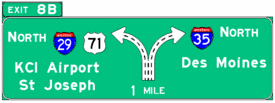
Support. Diagrammatic signs are guide signs that show a graphic view of the exit arrangement in relationship to the main highway. Use of such guide signs has been shown to be superior to conventional guide signs for some interchanges. Diagrammatics are used conservatively and for unusual or unexpected conditions. Use of this type of guide is suggested for any one of the following conditions:
A. All left hand exits including left hand lane drops,
B. In areas where driver confusion is possible due to existing conditions,
C. Multiple lanes with multiple exits closely spaced, or
D. Major divergences.
Major divergences do not include dual lane off ramps for diamond, cloverleaf, or directional interchanges.
Standard. Diagrammatic signs shall be designed according to the following criteria:
A. The graphic legend shall be of a plan view showing the off-ramp arrangement (see Figure 903.8.24.1(E-3)).
B. No other symbols or route shields shall be used as a substitute for arrowheads.
C. They shall not be installed at the exit direction location (see Exit Direction Signs).
D. The EXIT ONLY panel shall not be used on diagrammatic signs at any major split.
Type A, B, or C arrows shall not be used on diagrammatic signs. Diagrammatic arrow "branches" shall always curve with a radius and point to approximately the lower half of the shield for state routes, and to the street name for other than state routes. Normally, the main stem of the arrow represents the main line and points towards the top of the sign. Main line information shall be placed at the top of the sign, on the side of the arrow without branches.
Guidance. Diagrammatic signs should be designed according to the additional criteria:
A. The graphic is not to depict deceleration lanes.
B. No more than one destination should be shown for each arrowhead, and no more than two destinations should be shown per sign.
C. A black on fluorescent yellow EXIT ONLY panel should be used to supplement a lane drop graphic.
D. The shaft for the exit ramp movement should be shorter than, but not separated from, the through movement graphic. Where the movements are freeway splits rather than exits, the shafts should be equal in length.
E. Arrow shafts should contain lane lines where appropriate.
F. Route shields, cardinal directions and destinations should be clearly related to the arrowhead, and the arrowhead should point toward the route shield for the off movement.
G. The cardinal direction should be placed adjacent to the route shield and the destination should be placed below and justified with the route shield.
Diagrammatic signs should be used at the Advance Guide sign location(s) for:
A. Left exits (see Figure 903.8.24.1 (2E-3)).
B. Splits where the off-route movement is to the left (see Figure 903.8.24.2).
C. Optional lane splits for non-overlapping routes (see Figure 903.8.24.3).
D. Where a two-lane exit has an optional lane that carries the through route (see Figures 903.8.24.4 and 903.8.24.5). These interchanges create serious expectancy problems for drivers who are unfamiliar with the interchange.
E. Left exit interchange lane drop situations. In this situation, an EXIT ONLY (E3-2) panel should be used without a down arrow for Advance Guide signs (see Figure 903.8.24.6).
Diagrammatic signs shall always be mounted overhead, centered over all traffic lanes, and with no other guide sign.
Only one exit number panel should be placed over what is considered the exit side of a diagrammatic sign. The exit panel should be horizontally centered over the widest line of copy on the exit side.
Standard. Diagrammatic signs have been shown to be inferior to conventional signs at cloverleaf interchanges and shall not be used at these locations.
Support. Specific guidelines for more detailed design of diagrammatic signs are contained in Sign Detail and the federal Standard Highway Signs (see EPG 903.19.11).
Arrows require special detail information for arrow radii, angle of turn, stem length, etc. Sufficient information is provided on a special sign detail sheet for assembly by sign fabricators. The arrow stem represents the existing number of lanes directly under the sign. Lanes are picked up or dropped on the arrow above the stem, in order to represent number of traffic lanes. Arrows are constructed from the L-3 type of legend.
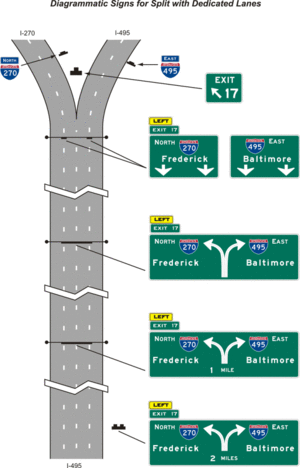
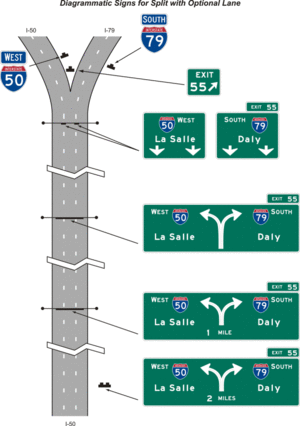
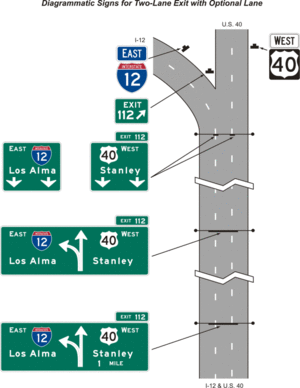
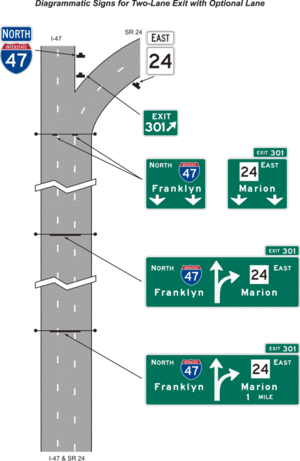
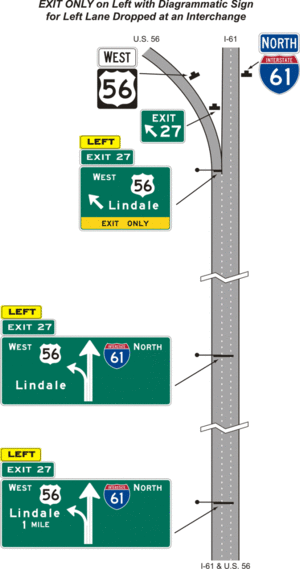
903.8.24.1 Signing for Route Termination (MUTCD Section 2E.19a)
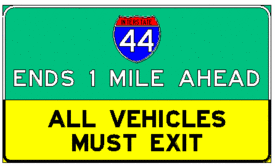
Standard. In advance of the termination of any route, a sign shall be installed to indicate the route ends and all traffic must exit. The sign shall include the shield of the route, which terminates with a relevant text message, such as “ALL VEHICLES MUST EXIT”.
903.8.24.2 Signing for Route Name Change. (MUTCD Section 2E.19b)
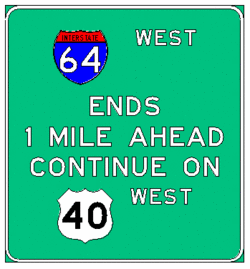
Standard. In advance of the location where a route name changes, a sign shall be erected indicating “(Rte. XXX) Ends Continue on (Rte. YYY)”. If Route XXX and YYY use different cardinal directions, then they should be included as modifiers to the route shields.
Support. For termination of conventional roads see EPG 903.7.22.
903.8.25 Signing for Interchange Lane Drops (MUTCD Section 2E.20)
 |
Standard. Major guide signs for all lane drops at interchanges shall be mounted overhead. An EXIT ONLY panel shall be used for all interchange lane drops at which the through route is carried on the mainline and when a continuous lane is dropped at an interchange, and the lane being dropped is a minimum of 2500 ft. in length from full lane width to the driving pavement exit gore point.
Guidance. The EXIT ONLY (down arrow) (E3-3) panel should be used on all signing of lane drops on all Advance Guide signs for right exits and appropriate Exit Direction signs (see Figure 903.8.25). For lane drops on the left side, diagrammatic signing with the EXIT ONLY (E3-2) panel should be used without a down arrow for Advance Guide signs (see Figure 903.8.24.5).
Option. The EXIT ONLY message may also be used in a situation of a weave lane where the weave lane is 1,000 ft. or greater in length or where the terminus of the lane is not visible to the driver.
Standard. EXIT ONLY legends shall only be used on overhead signs and be centered over the lane being dropped. The Exit Direction sign and E3-2 panel shall be of the format shown in Figures 903.8.24.5 and 903.8.25 for all lane drops. The standard slanted up arrow (left or right side) shall be included on the Exit Direction sign.
New EXIT ONLY legends shall be placed within the white border of the guide sign. This panel shall span the entire sign width along the bottom of a guide sign, except for diagrammatic signs.
Where an exit only situation exists but overhead signing of the exit only is not possible the RIGHT LANE EXIT ONLY (E11-2st) sign shall be used.
Option. EXIT ONLY messages of a E3-2 format may be used to retrofit existing signing to warn of a lane drop situation ahead.
Standard. The E3-2 panel, if used on an existing nondiagrammatic sign, shall be placed between the lower destination message and the white down arrow.
The EXIT ONLY shall appear at the bottom of the sign, below all other necessary legend and shall consist of a black legend and border on a fluorescent yellow background. A black border is not necessary to separate the background colors of green and fluorescent yellow.
For Exit Only signs in advance of the exit, a vertical downward arrow shall be placed between the words “EXIT” and “ONLY” and be centered over the lane to the greatest extent possible. If a single EXIT ONLY sign is placed for two lanes of exiting traffic, the arrows shall be placed to the left of “EXIT” and a second arrow placed to the right of “ONLY”. For a two lane Exit Only sign, no arrow shall appear between “EXIT” and ONLY”.
No direct payment shall be made for EXIT ONLY legends. These legends shall be treated as a shield, arrow, or any other symbol or wording. Payment for this legend shall be included in the cost of the structural guide sign to which it is attached.
Guidance. Some single exit only lanes develop into dual exit only lanes. An advance EXIT ONLY guide sign should be placed over the single lane before it develops into two, then a second advance EXIT ONLY guide sign should be placed after both lanes are fully developed.
Advance Guide signs for lane drops within 1 mile of the interchange are not to contain the distance message.
Wherever the dropped lane carries the through route, diagrammatic signs should be used without the EXIT ONLY panel.

903.8.26 Basic Lane Reduction (MUTCD Section 2E.20a)
Guidance. When a lane is dropped on a multi-lane, high-volume, high-speed roadway by merging lanes (lane not dropped at an interchange), at least two overhead advance signs should be used. The first sign should indicate the lane that ends and a distance.
The last sign should indicate the lane that ends and an action line.
These signs should be black legend on fluorescent yellow background (STR4L-3), and placed over the lane that is ending. These signs should have 12 in. series E(M) letters, all capitalized.
Support. For example, the first line may read RIGHT LANE ENDS. The second line should provide a distance in feet or mileage such as "1000 FT" or "1/2 MILE". When sufficient distance is available, two advance distance signs are provided at 1 mile and 1/2 mile.
For another example, the first line states RIGHT LANE ENDS, and the second line may read "MERGE LEFT".
For typical 4-lane to 2-lane reductions see Figures 903.13.22 and 903.13.23.
903.8.27 Changeable Message Signs (MUTCD Section 2E.21)
Standard. Changeable message signs shall be capable of displaying several messages in a sequence. Such messages shall be changed manually, by remote control, or by automatic controls. Changeable message signs shall display pertinent traffic operational and guidance information only, not advertising.
Support. Because technology for changeable message signs continues to advance, a specific standard for changeable message signs is not practical. Considerations that influence the selection of the best sign for a particular application include conspicuity, legibility, operation and maintenance of the changeable message sign. This article applies to signs for use on freeway and expressway mainlines. It is recognized that similar signs might be used on ramps and at ramp terminals where smaller letter heights and the number of messages might differ from the provisions of this article.
Guidance. To the extent practical, the design and application of changeable message signs should conform to the general principles of this article. Within the context of Changeable/Dynamic Message Signs, these practices should be followed for mainline freeway and expressway applications:
A. Changeable message signs should be capital letters and have a desirable letter size of 18 in. or a minimum letter size of 10.6 in. Signs should be limited to not more than 3 lines with not more than 20 characters per line.
B. No more than two displays should be used within any message cycle.
C. Each display should convey a single thought.
D. The entire message cycle should be readable at least twice by drivers traveling at the posted speed, the off-peak 85th-percentile speed, or the operating speed.
Standard. Messages shall be centered within each line of legend. If more than one changeable message sign is visible to travelers, then only one such sign shall display a sequential message at any given time.
A three-line changeable message sign shall be limited to not more than two messages. Techniques of message display such as fading, exploding, dissolving or moving messages shall not be used.
903.8.28 Overhead Sign Installations (MUTCD Section 2E.22)
Support. Specifications for the design and construction of structural supports for highway signs have been standardized by the American Association of State Highway and Transportation Officials (AASHTO). Overcrossing structures can often serve for the support of overhead signs, and might in some cases be the only practical location that will provide adequate viewing distance. Use of these structures as sign supports will eliminate the need for additional sign supports along the roadside. Factors justifying the installation of overhead signs and installation information are given in Overhead Sign Installation. Vertical clearance of overhead signs is discussed in Mounting Height.
903.8.29 Lateral Offset (MUTCD Section 2E.23)
Standard. The minimum lateral clearance outside the usable roadway shoulder for ground-mounted freeway and expressway signs or for overhead sign supports, either to the right or left side of the roadway, shall be 6 ft. This minimum clearance shall also apply outside of a barrier curb. If located within the clear zone, the signs shall be mounted on crashworthy supports or shielded by appropriate crashworthy barriers.
Guidance. Where practical, a sign should not be less than 10 ft. from the edge of the nearest traffic lane. Large guide signs are to be removed farther still, preferably 30 ft. or more from the nearest traffic lane.
Where an expressway median is 12 ft. or less in width, consideration should be given to spanning both roadways without a center support.
Where overhead sign supports cannot be placed a reasonably safe distance away from the line of traffic or in an otherwise protected site, they should either be designed to minimize the impact forces or be adequately shielded by a physical barrier or guardrail of suitable design. Refer to EPG 606 Guardrail and Guard Cable, for more information.
Standard. Butterfly-type sign supports and other overhead noncrashworthy sign supports shall not be installed in gores or other unprotected locations within the clear zone.
Option. Lesser clearances, but not generally less than 6 ft., may be used on connecting roadways or ramps at interchanges.
903.8.30 Guide Sign Classification (MUTCD Section 2E.24)
Support. Freeway and expressway guide signs are classified and treated in the following categories:
A. Route signs and Trailblazer Assemblies;
B. At Grade Intersection signs;
C. Interchange signs (refer to EPG 903.8.34 through 903.8.43);
D. Interchange Sequence signs;
E. Community Interchanges Identification signs;
F. NEXT X EXITS signs;
G. General Service signs;
H. Rest and Scenic Area signs;
I. Tourist Information and Welcome Center signs;
J. Reference Location signs;
K. Miscellaneous guide signs;
L. Radio Information signing;
M. Carpool and Ridesharing signing;
N. Weigh Station signing;
O. Specific Service signs (see EPG 903.9); and
P. Recreational and Cultural Interest Area signs (see EPG 903.11).
903.8.31 Route Signs and Trailblazer Assemblies (MUTCD Section 2E.25)
Standard. The official Route sign for the Interstate Highway System shall be the red, white and blue retroreflective distinctive shield adopted by AASHTO (see EPG 903.7.10).
Guidance. Route signs should be incorporated as cut-out shields or other distinctive shapes on large directional guide signs. Where the Interstate shield is displayed in an assembly or on the face of a guide sign with U.S. or state route signs, the interstate numeral should be at least equal in size to the numerals on the other Route signs. The use of independent Route signs should be limited primarily to route confirmation assemblies.
Route signs and auxiliary signs showing junctions and turns should be used for guidance on approach roads, for route confirmation just beyond entrances and exits and for reassurance along the freeway or expressway. When used along the freeway or expressway, the Route signs should be enlarged as shown in Standard Highway Signs (see EPG 903.19.11). When independently mounted Route signs are used in place of Pull-through signs, they should be located just beyond the exit.
Only standard sizes should be used for guide signs and independent use.
Route shields should be placed before street names and destinations, usually in the first line of the legend.
For all other routes, the word BUSINESS should appear above and horizontally centered over the shield on guide signs.
Support. Shields are detailed in the standard plans. Numbered primary, U.S. and interstate route shields have two widths available for each type of mount: one for two digit routes and one for three digit routes.
A business plaque is available in the standard plans for independent use only.
Option. The standard Trailblazer Assembly may be used on roads leading to the freeway or expressway. Component parts of the Trailblazer Assembly may be included on a single sign panel. Independently mounted Route signs may be used instead of Pull-Through signs as confirmation information (see EPG 903.8.11). The commonly used name or trailblazer symbol for a toll facility may be displayed on nontoll sections of interstates at:
A. The last exit before entering a toll section of an interstate;
B. The interchange or connection with a toll facility, whether or not the toll facility is a part of an interstate; and
C. Other locations within a reasonable approach distance of toll facilities when the name or trailblazer symbol for the toll facility would provide better guidance to travelers unfamiliar with the area than would place names and route numbers.
The toll facility name or symbol may be included as a part of the guide sign installations on intersecting highways and approach roads to indicate the interchange with a toll section of an interstate. Where needed for the proper direction of traffic, a trailblazer for a toll facility that is part of an interstate may be displayed with the Interstate Trailblazer Assembly.
The word “TO” may be used when a guide sign is acting similar to a trailblazer. Some turning movements for roadways may lead to a route, but they may also have other possible destinations.
Standard. The word “TO” shall only be used to trailblaze to a route, not a destination. The word “TO” shall be vertically centered on the shield, and shall be placed before the shield to read properly.
When a conflict arises between “TO” and a cardinal direction on the left of a shield, place “TO” first (starting from left hand side), then the shield, then the cardinal direction.
903.8.32 Signs for Intersections At Grade (MUTCD Section 2E.26)
Guidance. If there are intersections at grade within the limits of an expressway, guide sign types specified in EPG 903.7 should be used. However, such signs should be compatibly sized with other signing on the expressway.
Advance Guide signs for intersections at grade may take the form of diagrammatic layouts depicting the geometrics of the intersection along with essential directional information.
903.8.33 Interchange Guide Signs (MUTCD Section 2E.27)
Standard. The signs at interchanges and on their approaches shall include Advance Guide signs and Exit Direction signs. Consistent destination messages shall be displayed on these signs.
Guidance. New destination information should not be introduced into the major sign sequence for one interchange, nor should destination information be dropped.
Refer to EPG 903.8.11 and 903.8.24 through 903.8.48 for a detailed description of the signs in the order that they should appear at the approach to and beyond each interchange. Guide signs placed in advance of an interchange deceleration lane should be spaced at least 800 ft. apart.
Supplemental guide signing should be used sparingly as provided in EPG 903.8.38.
903.8.34 Interchange Exit Numbering (MUTCD Section 2E.28)
Support. Interchange exit numbering provides valuable orientation for the traveler on a freeway. The feasibility of numbering interchanges or exits on an expressway will depend largely on the extent to which grade separations are provided.
Standard. Interchange numbering shall be used in signing each freeway interchange exit. Exits are numbered for the interstate system only, and coincide with mileposts. Interchange exit numbers shall be displayed with each Advance Guide sign, Exit Direction sign and Gore sign. The exit number shall be displayed on a separate plaque at the top of the Advance Guide or Exit Direction sign. The standard exit number plaque shall include the word EXIT, the appropriate exit number, and the suffix letter (on multi-exit interchanges) separated from the exit number by a space in a single-line format on a plaque 30 in. tall. Exit numbers shall not include the cardinal initials corresponding to the directions of the cross route.
Since exits are numbered on the interstate system, the terms NEXT LEFT, NEXT RIGHT, or SECOND LEFT, SECOND RIGHT and NEXT EXIT shall not be used, with the exception of supplemental signs. The exit number shall always be referred to on the exit number panel that is placed above the main guide sign. For interstate guide signs, the term EXIT XX MILES shall not be used.
If a guide sign exit number panel refers to two exits, the exit number letters shall appear in the same order as the driver approaches them.
Option. Exit numbers may also be used with Supplemental Guide signs, after approval of Traffic Division, and Traveler Service signs.
Guidance. Supplemental guide signs are not to have exit number panels placed above the main sign.
Exit number plaques should be located toward the top left edge of the sign for a left exit and toward the top right edge for right exits.
Because travelers might not expect a left exit and might have difficulty in maneuvering to the left, the word LEFT should be added to the exit number plaque (see Figure 903.8.24.1 (2E-3)). Where a left exit is not numbered (no exit number plaque), a plaque with the word LEFT should be added to the top left edge of the sign.
Option. The portion of the exit number plaque containing the word LEFT may have a black legend and border on a fluorescent yellow background.
Support. The general plan for numbering interchange exits is shown in Figures 903.8.34.1 through 903.8.34.3. Figures 903.8.11, 903.8.46 and 903.8.58.1 through 903.8.58.5 illustrate the incorporation of exit number plaques on guide signs.
An example of how to display the distance on a guide sign: the exit panel will show EXIT 23, and the distance in the main guide sign will show 3/4 MILE.
Exit numbers are based on the milepost number in which the crossroad centerline ties to the mainline centerline. For example, if milepost 24 falls before the crossroad centerline and also between two exit ramps for a standard cloverleaf, the exits are numbered 24A, 24B. In this example, exit 24A appears before milepost 24. For the opposite direction in this example, the exit numbers are reversed (24B, 24A) in order to have both ramps numbered 24B accessing the same direction on the crossroad. Generally Ramp A will be placed at a log mile that is lower than the log mile for Ramp B. This may not be the case for complex or closely spaced interchanges.
Standard. State maps show the exit numbers for interstates with a different number for each exit. To avoid confusion, separate interchanges are not numbered the same. For example, EXIT 1C is for northbound I-55 exiting to eastbound U.S. Route 199. There should not be another EXIT 1C on southbound I-55, except for an exit to eastbound U.S. Route 199. If this exit does not exist on southbound I-55, there is no EXIT 1C on southbound I-55. When changing existing exit numbers is required, contact the Mapping Section in Support Center General Services in order for the state map to be updated.
Where a route originates within a state, the southernmost or westernmost terminus shall be the beginning point for numbering. If a loop, spur, or circumferential route crosses state boundaries, the sequence of numbering shall be coordinated by the states to provide continuous numbering.
Each exit ramp shall have a unique designation. Ramps from opposite directions on the mainline, that take motorists to the same destination, shall have the same exit number. Ramps that serve a movement in one direction, but don’t have a ramp serving traffic from the other direction of travel on the mainline shall have a unique exit number. If more than one exit ramp is located within the same physical mile marker of the mainline and physically exits the mainline separately (i.e. clover leaf interchange), then the exit shall be named with the mile marker number and a supplementary letter. Supplemental letter shall not be used when an exit peels off the mainline and then splits (i.e. directional interchange), unless there is a special circumstance that would require supplemental letter at the interchange. The letters shall begin with “A” and continue in alphabetical order. Any mile of roadway that has an exit with an “A” shall also have at least an exit “B”. Exits shall be supplemented with letters using “A” at the western-most or southern-most exit within a mile marker. The highest letter shall always be used at the eastern-most or northern-most exit within a mile marker. In the event that all of the ramps for the same interchange do not fall within the same mile marker, use the mile marker in which the centerline of the intersecting route falls within.
For circumferential routes, the numbering of interchanges shall be in a clockwise direction. The numbering shall begin with the first interchange west of the south end of an imaginary north-south line bisecting the circumferential route, at a radial freeway or other interstate route, or some other conspicuous landmark in the circumferential route near a south polar location (see Figure 903.8.34.1 (2E-12)). The interchange numbers on loop routes shall begin at the loop interchange nearest the south or west mainline junction and increase in magnitude toward the north or east mainline junction (see Figure 903.8.34.2). Spur route interchanges shall be numbered in ascending order starting at the interchange where the spur leaves the mainline of the principal route (see Figure 903.8.34.2).
Guidance. The route chosen for continuity of interchange numbering is also to have reference location sign continuity (see Figure 903.8.34.3).
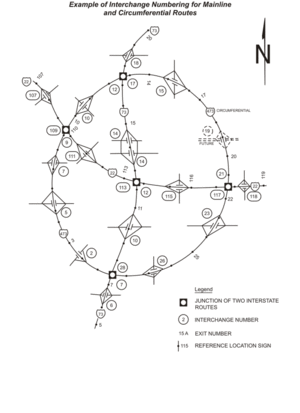
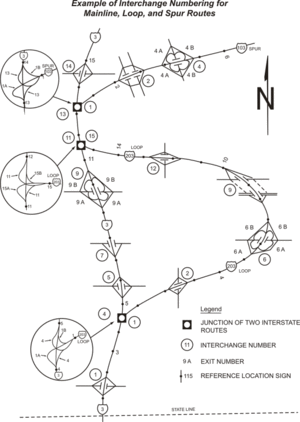
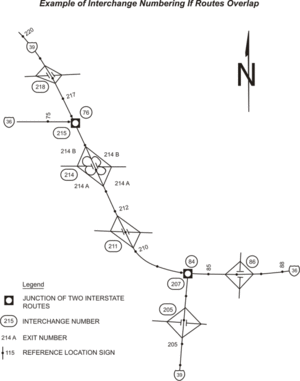
903.8.35 Interchange Classification (MUTCD Section 2E.29)
Support. For signing purposes, Missouri does not classify interchanges as major, intermediate and minor.
903.8.35.1 Guide Sign Distance. (MUTCD Section 2E.29a)
Support. For interchanges, all guide sign distances are calculated from the advance sign location to the exit gore. Guide signs are located as close to the actual distance as possible. Guide sign distances do not have to be exact, but they should be as close as practical. For intersections, the stop bar or beginning of the crossroad radius is used to set guide sign distances. When referencing to a cloverleaf or another design where the exit ramps for the same route are separated by an appreciable distance, advance guide sign distances refer to the first exit gore.
Guidance. Only mileage distances rounded to the nearest 1/4 mile should be used on guide signs. Only three fractions should be used, 1/4, 1/2 and 3/4. The fraction nearest to the actual distance should be used.
All distances one mile or less should be treated as singular.
Distances are not to be placed above EXIT ONLY panels for any distance less than one mile.
Support. For example, proper terminology is "1 MILE" and "1 ¼ MILES".
903.8.35.2 Street Names on Guide Signs. (MUTCD Section 2E.29b)
Option. The public often makes reference to MoDOT routes by name instead of the official MoDOT route identification number or letter. If this is the case, the route name may be used in conjunction with the MoDOT route shield. The route shield and, if required, the cardinal direction appear on the first line of copy, and the second line indicates the route name. All route names carry the appropriate designation as street (St), boulevard (Blvd), road (Rd), avenue (Ave), drive (Dr), etc (see Table 903.19.14).
Guidance. Control cities (see Table 903.8.13) should be used in place of route names when both conditions exist.
Using a route shield, a control city and a route name on the same sign should be avoided whenever possible. Some situations require a route shield, a control city and a street name, with the street name being a separate roadway or exit than the MoDOT route. For this condition, the order should be route shield, control city (or major destination) and then the street name as the third line of copy, regardless of roadway geometrics.
903.8.35.3 Street Identification/Orientation Street Name Signs. (MUTCD Section 2E.29c)

Support. Street Identification/Orientation Street Name signs (D-3c) are bridge-mounted where roadways over state routes are not provided direct access by an interchange. They are for general knowledge only and show the name of the roadway overpass.
Standard. Street identification signs shall not be used on bridges for ramps, pedestrian overpasses or railroad bridges passing over state routes.
These signs shall be placed over the shoulder of the state route. If other signs are in conflict with this location, the sign shall be placed approximately 6 in. from the edge of the nearest sign and always away from the centerline of the state route. The following sign criteria is standard: STR2L-3, upper/lower case letter heights of 8/6 in., series E(M), 2 ft. tall by a variable width.
Street Identification/Orientation Street Name sign support brackets shall be designed by the Bridge Division as stated in EPG 903.3.7. This type of sign is not required when roadways pass underneath a state route with no direct access.
Guidance. If it is not possible to mount the Street Identification/Orientation Street Name sign on the structure, the sign should be post-mounted as close to the structures as possible.
903.8.36 Advance Guide Signs (MUTCD Section 2E.30)
 |
 |
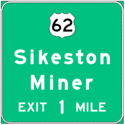 |
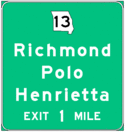 |
 |
 |
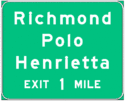 |
Support. The Advance Guide sign gives notice well in advance of the exit point of the principal destinations served by the next interchange and the distance to that interchange on expressways or freeways. In rural areas, this sign will typically be a ground mount sign. In urban areas, this sign will usually be found overhead.
Guidance. Advance guide signs should be placed over any convenient lane, preferably over the right lane for right hand exits and over the left lane for left hand exits. Two advance guide signs are not to be placed side by side. This can create confusion.
For typical interchanges, Advance Guide signs should be placed 1 mile in advance of the exit. When used at freeway-to-freeway or directional interchanges, the additional Advance Guide sign should be located at a distance of 2 miles in advance of the interchange. If used, fractions of a mile, rather than decimals, should be shown in all cases.
Where Advance Guide signs are provided for a left exit, diagrammatic signs should be used.
Standard. Freeway-to-freeway and directional interchanges shall use one additional Advance Guide sign in each direction.
When used, Advance Guide signs shall contain the distance message. The legend on the Advance Guide signs shall be the same as the legend on the Exit Direction sign, except that the last line shall read EXIT X MILES. If the interchange has two or more exit roadways, the bottom line shall read EXITS X MILES.
The EXIT ONLY message shall be used to advise drivers of the imminent lane drop situation. The sign shall conform to the provisions of EPG 903.8.25.
The E3-1 exit number plaque containing the word EXIT shall be used above the Exit Direction sign on interstates only.
Option. The Advance Guide sign placement distances may be adjusted as necessary due to field conditions in ¼ mile increments.
Where interchange exit numbers are used, the word EXIT may be omitted from the bottom line. Where the distance between interchanges is more than 1 mile, but less than 2 miles, the first Advance Guide sign may be closer than 2 miles, but not placed so as to overlap the signing for the previous exit. Duplicate Advance Guide signs or Interchange Sequence Series signs may be placed in the median on the opposite side of the roadway and are not included in the minimum requirements of interchange signing.
Complex directional interchanges may benefit from a limited number of additional Advance Guide signing.
Guidance. Where there is less than 800 ft. between interchanges, Interchange Sequence Series signs should be used instead of Advance Guide signs for the affected interchanges.
903.8.37 Next Exit Supplemental Signs (MUTCD Section 2E.31)

Option. Where the distance to the next interchange is 5 miles or more, Next Exit supplemental signs may be installed to inform travelers of the distance to the next interchange.
Guidance. The Next Exit supplemental sign should not be used unless the distance between successive interchanges is more than 5 miles.
Standard. The Next Exit supplemental sign shall carry the legend NEXT EXIT X MILES. If the Next Exit supplemental sign is used, it shall be placed below the Advance Guide sign nearest the interchange. It shall be mounted so as to not adversely affect the breakaway feature of the sign support structure.
Option. The legend for the Next Exit supplemental sign may be displayed in either one or two lines. The one-line message is the more desirable choice unless the message causes the sign to have a horizontal dimension greater than that of the Advance Guide sign.
903.8.38 Other Supplemental Guide Signs (MUTCD Section 2E.32)

Support. Supplemental Guide signs can be used to provide information regarding destinations accessible from an interchange, other than places shown on the standard interchange signing. However, such Supplemental Guide signing can reduce the effectiveness of other more important guide signing because of the possibility of overloading the traveler's capacity to receive visual messages and make appropriate decisions. “The AASHTO Guidelines for the Selection of Supplemental Guide Signs for Traffic Generators Adjacent to Freeways” is incorporated by reference in this section (see Page i for AASHTO’s address).
This class of sign includes College and Major Traffic Generator signs. Major traffic generator signs and recreational area signs are white on brown; most other supplemental signs are white on green.
Guidance. Supplemental Guide signs should be ground mounted when adequate space is available, regardless of other guide signs being overhead or ground mounted.
No more than one Supplemental Guide sign should be used on each interchange approach.
A Supplemental Guide sign is not to list more than two destinations. Destination names should be followed by the interchange number (and suffix), or if interchanges are not numbered, by the legend NEXT RIGHT/LEFT or SECOND RIGHT/LEFT or both, as appropriate.
Where two or more Advance Guide signs are used, the Supplemental Guide sign should be installed approximately midway between two of the Advance Guide signs. If only one Advance Guide sign is used, the Supplemental Guide sign should follow it by at least 800 ft. If the interchanges are numbered, the interchange number should be used for the action message.
Standard. Supplemental Guide signs shall be mounted independently.
Guide signs directing drivers to park and ride facilities shall be considered as Supplemental Guide signs.
903.8.39 Traffic Generator Signing (MUTCD Section 2E.32a)

Support. MoDOT’s policy on signing for traffic generators is defined in the following rules and regulations. These regulations can be found under the Code of State Regulations Title 7, Division 10, Chapter 17, (7 CSR 10-17.010).
Standard. To qualify for traffic generator signing, the facility must qualify as being a minor, major, or super traffic generator. The owner of the traffic generator shall enter into an agreement with the commission to establish the following conditions:
1. A fee, payable in advance, shall be paid by the owner of the traffic generator facility. The fee will approximate the cost to fabricate and install all signs erected by the commission directing traffic to the facility. This fee is not refunded if the signs are removed.
2. The owner of the traffic generator shall cover all costs incurred by the Department to replace and/or maintain the generator signing. This includes all maintenance and/or replacement required to meet MoDOT standards. All maintenance and materials shall be completed and/or supplied by MoDOT.
3. When a seasonally operated traffic generator is closed the Commission shall place an approved “closed” sign across the signs. The owner of the traffic generator shall be responsible for all costs incurred.
4. The owner of the traffic generator shall meet the continued compliance with all conditions of the agreement and specific criteria to qualify as a traffic generator or the commission may remove the signs. The following definitions shall relate to signs for traffic generators:
A. Major traffic generator means a traffic generator that attracts the following:
- 1. At least 300,000 visitors per year in the St. Louis or Kansas City metropolitan areas;
- 2. At least 250,000 visitors per year in an area with a population of at least 5,000 persons (urban area); and
- 3. At least 200,000 visitors per year in an area in which the population is less than 5,000 persons (rural area).
B. Minor traffic generator means a traffic generator, which attracts at least 25,000 persons per year (only on conventional routes);
C. Second order signing means signs that are installed in advance of the intersection or interchange where motorists turn to access the highway where first order signing is provided;
D. Super traffic generator means a traffic generator, which attracts at least 1 million visitors per year;
E. Third order signing means signs that are installed in advance of the intersection or interchange where motorists turn to access the highway where second order signing is provided; and
F. Traffic generator means a publicly or privately owned scenic, historical, educational, cultural or recreational site or a natural wonder (state approved cave) which generates a large volume of traffic due to public visitors to the site each year.
The eligibility requirements for traffic generators are as follows:
A. Minor Traffic Generators:
- 1. A minimum of 25,000 annual attendance in required.
- 2. Only first order signing will be provided for minor traffic generators and only on conventional routes.
- 3. If the minor traffic generator is a cave, the cave must be state approved.
- 4. If the minor traffic generator is a historical site, the historical site must be listed in the National Register of Historic Places.
- 5. The minor traffic generator site must be within 6 miles from the intersection where the first order signing should be installed.
- 6. A maximum of 1 sign for each approach shall be provided for a minor traffic generator and up to a maximum of 2 approaches.
B. Major Traffic Generators:
- 1. To be eligible for first, second or third order signing on a freeway, the major traffic generator must meet the following criteria:
- a. Be fully operative and open to the traveling public for a minimum of 3 months each year;
- b. Be located along either the interchange crossroad or the freeway and within 6 miles of the major traffic generator in a rural area or within 2 miles in an
urban or metro area; and
- c. Meet the annual attendance requirements as provided in the definitions
section of this rule.
- 2. A maximum of 1 freeway sign for each approach shall be provided for a major traffic generator and up to a maximum of 2 approaches.
C. Super Traffic Generators:
- 1. To be eligible for first, second and third order signing on freeways, super traffic generators must meet the following criteria:
- a. An annual minimum attendance of 1 million; and
- b. The facility is fully operative and open to the traveling public for a minimum of 3 months each year.
- 2. Signs may be provided on each freeway located within 10 miles of the super
traffic generator site in a rural area or within 2 miles in an urban or metro area.
- 3. A maximum of 1 freeway sign for each approach shall be provided for a super
traffic generator.
The commission shall allow only ground-mounted traffic generator signs. Therefore, if there is lack of sufficient ground space to accommodate the placement of the sign without interfering or conflicting with required signing, the commission has the right to deny a request for the sign.
In addition, if there is limited sufficient ground space, super traffic generators have priority over major traffic generators, which have priority over minor traffic generators.
When 2 or more traffic generators are located in the same area, the commission may combine signing of such traffic generators on one 1 sign and the fees will be divided between the traffic generators.
The sign legend will include only the name of the traffic generator and directional information.
The final design and legend specifications for each sign are the decision of the Commission.
In addition to the above fees, any non-conforming commercial billboard advertising by the traffic generator located adjacent to the freeway within 5 miles of the interchange crossroad or the nearest adjacent interchange, whichever is the shorter distance, shall be voluntarily removed except on-premise signs.
The implementation of the supplemental guide signing under the terms of the Commission criteria shall require acquisition by the district of the following:
A. Verification of the annual attendance.
B. The usage period of the signs, if the generator is of seasonal nature.
C. Acceptance by the owner of the generator of the conditions involving the fee for the signs and the removal of existing commercial outdoor advertising.
D. Recommendation of sign location and legend.
Following receipt of this information by the Traffic Division, a Tr-15 contract will be executed between the District Engineer and the owner of the generator shall be prepared. The Traffic Division shall develop the actual design and the fees, which will be required for the sign. A requisition for the signs shall be honored upon execution of the TR-15 contract and payment of the fees. The actual preparation and execution of the TR-15 contract shall be as follows:
A. The district will request approval for the signing from the State Traffic Engineer. This request will include the information noted above.
B. If the generator signing is approved, the State Traffic Engineer shall provide the sign description and fees required for inclusion into the agreement.
C. The generator management and the district office will complete the TR-15 contract and provided a copy to the State Traffic Engineer and copies to those on the distribution list.
903.8.40 Exit Direction Signs (MUTCD Section 2E.33)
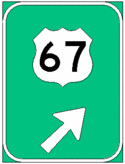 |
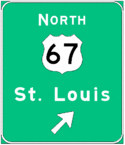 |
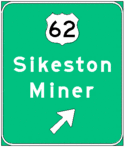 |
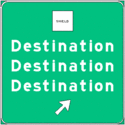 |
 |
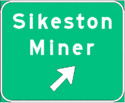 |
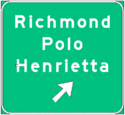 |
Support. The Exit Direction sign repeats the route and destination information that was shown on the Advance Guide sign(s) for the next exit, and thereby assures travelers of the destination served and indicates whether they exit to the right or the left for that destination.
Standard. Exit Direction signs shall be used at interchanges. Population figures or other similar information shall not be used on Exit Direction signs.
Guidance. Ground-mounted Exit Direction signs should be installed at the beginning of the deceleration lane. If there is less than 300 ft. from the beginning of the deceleration lane to the theoretical gore (see Figure 620.XX (3B-8)), the Exit Direction sign should be installed overhead over the exiting lane in the vicinity of the theoretical gore.
Standard. Where a through lane is being terminated (dropped) at an exit, the Exit Direction sign shall be placed overhead at the theoretical gore (see Figures 903.8.24.5 and 903.8.25).
The following provisions shall govern the design and application of the overhead Exit Direction sign:
A. The sign shall carry the exit number (if used), the route number, cardinal direction, and destination with an appropriate upward slanting arrow.
B. The message EXIT ONLY in black on a fluorescent yellow panel shall be used on the overhead Exit Direction sign to advise travelers of a lane drop situation. The sign shall conform to the provisions of EPG 903.8.25.
C. Diagrammatic signs shall not be employed at the exit direction location. The E1-5ST exit number plaque containing the word EXIT shall be used above the exit gore signs on interstates only.
Guidance. Exit number plaques should be located toward the left edge of the sign for a left exit and toward the right edge for right exits.
Option. In some cases, principally in urban areas, where restricted sight distance because of structures or unusual alignment make it impossible to locate the Exit Direction sign without violating the required minimum spacing (see 903.8.36) between major guide signs, Interchange Sequence signs (see 903.8.45) may be substituted for an Advance Guide sign.
Guidance. At multi-exit interchanges, the Exit Direction sign should be located directly over the exiting lane for the first exit. At the same location, and normally over the right through lane, an Advance Guide sign for the second exit should be located. Only for those conditions where the through movement is not evident is a confirmatory message (Pull-through sign) to be used over the left lane(s) to guide travelers traveling through an interchange. In the interest of sign spreading, three signs on one structure are not to be used. When the freeway or expressway is on an overpass, the Exit Direction sign should be installed on an overhead support over the exit lane in advance of the gore point.
Option. If the second exit is beyond an underpass, the Exit Direction sign may be mounted on the face of the overhead structure.
903.8.41 Exit Gore Signs (MUTCD Section 2E.34)
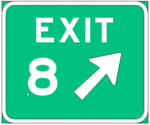 |
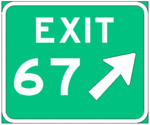 |
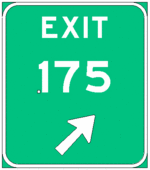 |
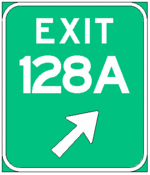 |
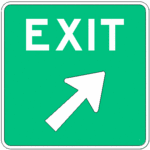 |
Support. The Exit Gore (E5 series) sign in the gore indicates the exiting point or the place of departure from the main roadway. Consistent application of this sign at each exit is important.
Standard. The gore shall be defined as the area located between the main roadway and the ramp just beyond where the ramp branches from the main roadway. The Exit Gore sign shall be located in the gore and shall carry the word EXIT and an appropriate upward slanting arrow. Breakaway or yielding supports shall be used.
The exit numbers shall be incorporated into the sign legend on interstate routes only.
Guidance. The arrow should be aligned to approximate the angle of departure. Each gore should be treated similarly, whether the interchange has one exit roadway or multiple exits.
903.8.42 Post-Interchange Signs (MUTCD Section 2E.35)
Guidance. If space between interchanges permits, as in rural areas, and where undue repetition of messages will not occur, a fixed sequence of signs should be displayed beginning 500 ft. beyond the end of the acceleration lane. At this point a Route sign assembly should be installed followed by a Speed Limit sign and a Distance sign, each at a spacing of 1,000 ft.
If space between interchanges does not permit placement of these three post-interchange signs without encroaching on or overlapping the Advance Guide signs necessary for the next interchange, or in rural areas where the interchanging traffic is primarily local, one or more of the post-interchange signs should be omitted.
Option. Usually the Distance sign will be of less importance than the other two signs and may be omitted, especially if Interchange Sequence signs are used. If the sign for through traffic on an overhead assembly already contains the route sign, the post-interchange route sign assembly may also be omitted.
903.8.43 Crossroad Guide Sign (MUTCD Section 2E.35a)
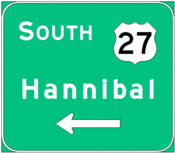 |
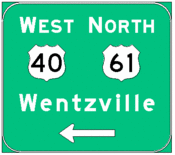 |
 |
Support. The Crossroad Guide (E8 series) sign is used on a crossroad to provide destination and direction for traffic entering an expressway or freeway.
Guidance. The destination used should be a control city (see Table 903.8.13) for interstate routes.
903.8.44 Distance Signs (MUTCD Section 2E.36)
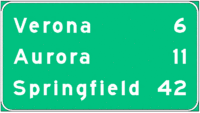
Standard. If used, the post-interchange Distance sign shall consist of a two- or three-line sign carrying the names of significant destination points and the distances to those points. The top line of the sign shall identify the next meaningful interchange with the name of the community near or through which the route passes, or if there is no community, the route number or name of the intersected highway.
Guidance. If a second line is used, it should be reserved for communities of general interest that are located on or immediately adjacent to the route or for major traffic generators along the route.
Option. The choice of names for the second line, if it is used, may be varied on successive Distance signs to give travelers maximum information concerning communities served by the route.
Standard. The third, or bottom, line shall contain the name and distance to a control city (if any) that has national significance for travelers using the route.
Guidance. Distances to the same destinations are not to be shown more frequently than at 5-mile intervals. The distances displayed on these signs should be the actual distance to the destination points and not to the exit from the freeway or expressway.
903.8.45 Interchange Sequence Signs (MUTCD Section 2E.37)
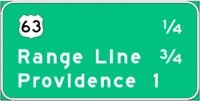 |
Guidance. If there is less than 800 ft. between interchanges, Interchange Sequence (E6-1) signs should be used instead of the Advance Guide signs for the affected interchanges. If used, Interchange Sequence signs should be used over the entire length of a route in an urban area. They are not to be used on a single interchange basis.
Option. If interchanges are closely spaced, particularly through large urban areas, so that guide signs cannot be adequately spaced, Interchange Sequence signs identifying the next two or three interchanges may be used.
Support. Interchange Sequence signs are generally supplemental to Advance Guide signs. Signing of this type is illustrated in Figure 903.8.45, and is compatible with the sign spreading concept.
These signs are installed in a series and display the next two or three interchanges by name or route number with distances to the nearest 1/4 mile.
Standard. If used, the first sign in the series shall be located in advance of the first Advance Guide sign for the first interchange. The sign shall not include any exit numbers.
An Interchange Sequence sign shall not be placed on a truss with any other guide sign, unless the sign faces the opposite direction of all other guide signs.
All interchanges shall be listed using the same name that will appear on the Advance Guide and Exit Direction signing for the interchange.
Where the exit direction is to the left, interchange names or route numbers shown on such signs shall be followed by the legend LEFT (E3-5) in black letters on a fluorescent yellow rectangular background.
Interchange Sequence signs shall not be substituted for Exit Direction signs.
Guidance. The verbiage on the Interchange Sequence sign should appear on the appropriate advance and exit guide signs for sign continuity.
Interchange Sequence signs should be located in the median or placed on a bridge whenever possible. After the first of the series, Interchange Sequence signs should be placed approximately midway between interchanges. This will allows two signs (one for each direction of traffic) to be placed back to back on the same truss. Since the signs are usually back-to-back, a butterfly truss should be installed in the median of divided highways. Barrier protection should be used according to the AASHTO Roadside Design Guide.
Standard. Interchange Sequence signs located in the median shall be installed at overhead sign height.
Option. When conditions arise where back-to-back sequence signs are not practical, an Interchange Sequence sign and truss may be placed on the right-hand side of traffic flow to avoid exposing opposite directions of traffic to a truss pedestal. If exposure to both directions of traffic is not a concern, this sign and truss may be placed at the standard location, on the left hand side of the traffic flow.
Support. An example of how to use a common street name: Route 67 is commonly referred to as Lindbergh Boulevard. On the advance and exit guide signs, a U.S. Route 67 shield appears with the common name “Lindbergh Boulevard” underneath. The interchange sequence signs show Lindbergh Blvd and/or shield.
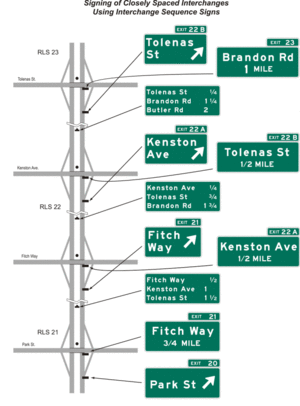
903.8.46 Community Interchanges Identification Signs (MUTCD Section 2E.38)
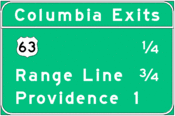
Support. For suburban or rural communities served by three or more interchanges, Community Interchanges Identification (E7-1) signs are useful.
Guidance. In these cases, the name of the community followed by the word EXITS should be shown on the top line; the lines below should display the destination, road name or route number, and the corresponding distances to the nearest ¼-mile. The sign should be located in advance of the first Advance Guide sign for the first interchange within the community.
Standard. The amount of destinations listed shall not exceed three.
Interchange exit numbers shall not be shown on Community Interchange Identification signs.
Option. If interchanges are not conveniently identifiable or if there are more than three interchanges to be identified, the NEXT X EXITS (E4-1a) sign (see EPG 903.8.47) may be used.
903.8.47 NEXT X EXITS Sign (MUTCD Section 2E.39)

Support. Many freeways or expressways pass through historical or recreational regions, or urban areas served by a succession of three or more interchanges.
Option. Such regions or areas may be indicated by a NEXT X EXITS (E4-1a) sign located in advance of the Advance Guide sign or signs for the first interchange. The sign legend should identify the region or area followed by the words NEXT X EXITS.
903.8.48 Overhead Intersection Ramp Guide Sign (MUTCD Section 2E.39a)
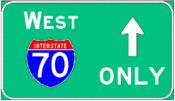
Support. The Overhead Intersection Ramp Guide (E9-1) sign may be used where required to provide direction from an interchange ramp at a signalized intersection.
Standard. The Overhead Intersection Ramp Guide sign shall be for overhead use only.
903.8.49 Signing by Type of Interchange (MUTCD Section 2E.40)
Support. Travelers need signs to help identify the location of the exit as well as to obtain route, direction and destination information for specific exit ramps. Figures 903.8.58.1 through 903.8.58.6 show examples of guide signs for common types of interchanges. The interchange layouts shown in most of the figures illustrate only the major guide signs for one direction of traffic on the through road and on the crossroad.
Standard. Interchange guide signing shall be consistent for each type of interchange along a route.
Guidance. The signing layout for all interchanges having only one exit ramp in the direction of travel should be similar regardless of the interchange type (see Figures 903.8.24.5, 903.8.26 and Figures 903.8.58.1 through 903.8.58.6). For the sake of uniform application, the significant features of the signing plan for each of the more frequent kinds of interchanges (illustrated in Figures 903.8.58.1 through 903.8.58.6) should be followed as closely as possible. Even when unusual geometric features exist, variations in signing layout should be held to a minimum.
903.8.50 Freeway-to-Freeway Interchange (MUTCD Section 2E.41)
Support. Freeway-to-freeway interchanges are major decision points where the effect of taking a wrong ramp cannot be easily corrected. Reversing direction on the connecting freeway or reentering to continue on the intended course is usually not possible. Figure 903.8.58.1 shows examples of guide signs at a freeway-to-freeway interchange.
Guidance. The sign messages should contain only the route shield, cardinal direction and the name of the next control city on the route. Arrows should point as indicated in EPG 903.7.7, unless a diagrammatic representation of the interchange layout requires otherwise.
At splits where the off-route movement is to the left or where there is an optional lane split, expectancy problems usually result and diagrammatic signs should be used at the Advance Guide sign location. Diagrammatic signs also should be used at the Advance Guide sign locations for interchanges where two-lane exits with an optional lane carry the through route on the exiting lanes.
Standard. Overhead signs shall be used at a distance of 1 mile and at the theoretical gore of each connecting ramp. When diagrammatic signs are used, they shall conform to the provisions of EPG 903.8.24.
Option. Overhead signs may also be used at the 0.5 mile and 2 mile points.
The arrow and/or the name of the control city may be omitted on signs that indicate the straight-ahead continuation of a route.
An Exit Speed sign may be used where an engineering study shows that it is necessary to display a speed reduction message for ramp signing (see EPG 903.6.38).
903.8.51 Cloverleaf Interchange (MUTCD Section 2E.42)
Support. A cloverleaf interchange has two exits for each direction of travel. The exits are closely spaced and have common Advance Guide signs. Examples of cloverleaf interchange guide signs are shown in Figure 903.8.58.2.
Guidance. The Advance Guide signs should include two place names, one corresponding to each exit ramp, with the name of the place served by the first exit on the upper line.
Standard. An Overhead Guide sign shall be placed at the theoretical gore point of the first exit ramp, with an upward slanting arrow on the exit direction sign for that exit and the message XX MILE on the Advance Guide sign for the second exit, as shown in Figure 903.8.58.2. The second exit shall be indicated by an overhead Exit Direction sign over the auxiliary lane. An Exit sign shall also be used at each gore (see EPG 903.8.41).
Interchanges with more than one exit from the main line shall be numbered as described in 903.8.34 with an appropriate suffix.
Diagrammatic signs shall not be used for cloverleaf interchanges.
Guidance. As shown in Figure 903.8.58.2, the overhead Exit Direction sign for the second exit should be mounted on the structure if the mainline passes under the crossroad and the exit roadway is located beyond the structure.
903.8.52 Cloverleaf Interchange with Collector-Distributor Roadways (MUTCD Section 2E.43)
Support. Examples of guide signs for full cloverleaf interchanges with collector-distributor roadways are shown in Figure 903.8.58.3.
Guidance. Signing on the collector-distributor roadways should be the same as the signing on the mainline of a cloverleaf interchange.
Standard. Guide signs at exits from the collector-distributor roadways shall be overhead and located at the theoretical gore of the collector-distributor roadway and the exit ramp.
Option. Exits from the collector-distributor roadways may be numbered with an appropriate suffix. The Advance Guide signs may include two place names and their corresponding exit numbers or may use the singular EXIT.
903.8.53 Partial Cloverleaf Interchange (MUTCD Section 2E.44)
Support. Examples of guide signs for partial cloverleaf interchanges are shown in Figure 903.8.58.4.
Guidance. As shown in Figure 903.8.58.4, the overhead Exit Direction sign should be placed on the structure if the mainline passes under the crossroad and the exit roadway is located beyond the structure.
Standard. A ground-mounted Exit Gore sign shall also be installed in the ramp gore.
903.8.54 Diamond Interchange (MUTCD Section 2E.45)
Support. Examples of guide signs for diamond interchanges are shown in Figures 903.8.58.5 and 903.13.15.
Standard. The singular message EXIT shall be used on the Advance Guide and Exit Direction signs. Exit numbers shall not include the cardinal initials corresponding to the direction of the cross route.
Support. The typical diamond interchange ramp departs from the mainline roadway so that a speed reduction generally is not necessary to permit a driver to negotiate an exit maneuver reasonably safely from the mainline onto the ramp roadway.
Guidance. When a speed reduction is not necessary, an exit speed sign is not to be used.
Option. An Exit Speed sign may be used where an engineering study shows that it is necessary to display a speed reduction message for ramp signing (see EPG 903.6.38).
Guidance. The Exit Speed sign should be located along the deceleration lane or along the ramp so that it is visible to the driver far enough in advance so that a reasonably safe slowing and exiting maneuver can be made.
Option. A Stop Ahead or Signal Ahead warning sign may be placed, where engineering judgment indicates a need, along the ramp in advance of the cross-street, to give notice to the driver (see EPG 903.6.31).
Guidance. When used on two-lane ramps, Stop Ahead or Signal Ahead signs should be used in pairs with one sign on each side of the ramp.
903.8.55 Diamond Interchange in Urban Area (MUTCD Section 2E.46)
Support. Examples of guide signs for diamond interchanges in an urban area are shown in Figures 903.8.58.5 and 903.13.15. This example includes the use of the Community Interchanges Identification sign (see EPG 903.8.46) that might be useful if two or more interchanges serve the same community.
In urban areas, street names are often shown as the principal message in destination signs.
Option. If interchanges are too closely spaced to properly locate the Advance Guide signs, they may be placed closer to the exit, and the distance figures adjusted accordingly.
903.8.56 Closely Spaced Interchanges (MUTCD Section 2E.47)
Option. When a series of interchanges is closely spaced, the advance guide sign for the next interchange may be mounted on an overhead structure located downstream from the gore of the preceding interchange.
Guidance. Interchange Sequence signs should be used at closely spaced interchanges. When used, they identify and show street names and distances for the next two or three exits as shown in Figure 903.8.46.
Standard. Advance Guide signs for closely spaced interchanges shall show information for only one interchange.
903.8.57 Minor Interchange (MUTCD Section 2E.48)
Support. Missouri does not classify interchanges as minor. Interchanges that are classified as minor in the MUTCD will be signed like all other interchanges of the same type.
903.8.58 Signing of Approaches and Connecting Roadways (MUTCD Section 2E.49)
Support. Because there are a number of different ramp configurations that are commonly used at interchanges with conventional roads, drivers on the conventional road cannot reliably predict whether they will be required to turn left or right in order to enter the correct ramp to access the freeway or expressway in the desired direction of travel. Consistently applied signing for conventional road approaches to freeway or expressway interchanges is highly desirable.
Guidance. The signing of conventional roads approaching an interchange should consist of a sequence containing the following signs (see Figure 903.13.15):
A. Junction Assembly
B. Destination sign
C. Directional Assembly for the first ramp
D. Advance Route Turn Assembly
E. Directional Assembly or Crossroad Guide sign for the second ramp
Standard. If used, the Crossroad Guide (see EPG 903.8.43) sign shall consist of a white legend and border on a green background. It shall contain the freeway or expressway route shield(s), cardinal direction, and directional arrow(s).
Option. If additional signing is needed an advance directional sign mounted overhead may be used to direct travelers to the appropriate lane.
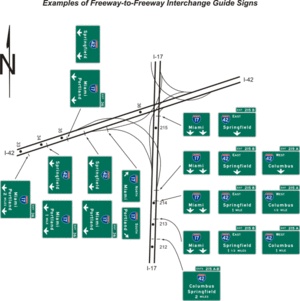
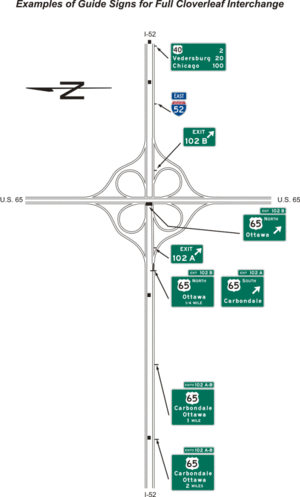
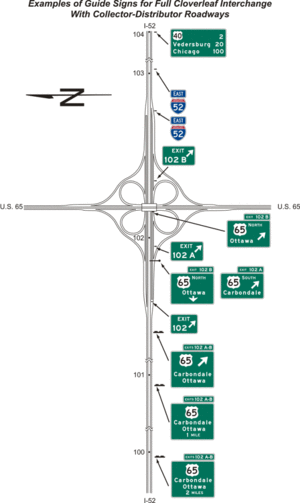
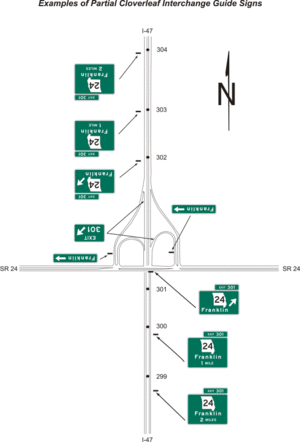
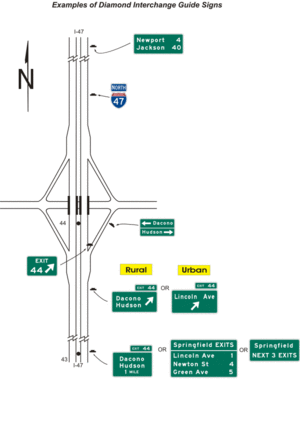
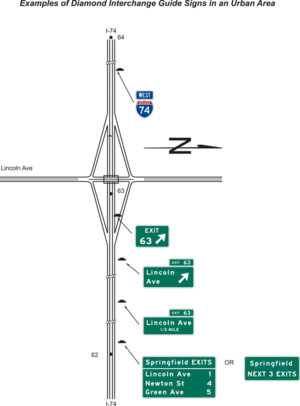
903.8.59 Wrong-Way Traffic Control at Interchange Ramps (MUTCD Section 2E.50)
Standard. At interchange exit ramp terminals where the ramp intersects a crossroad in such a manner that wrong-way entry could inadvertently be made, the following signs shall be used (see Figure 903.8.59.1):
A. At least one ONE WAY sign for each direction of travel on the crossroad shall be placed where the exit ramp intersects the crossroad.
B. At least one DO NOT ENTER sign shall be conspicuously placed near the end of the exit ramp in positions appropriate for full view of a traveler starting to enter wrongly.
C. At least one WRONG WAY sign shall be placed on the exit ramp facing a traveler traveling in the wrong direction.
Guidance. In addition, the following pavement markings should be used (see Figure 903.8.59.1):
A. On two-lane paved crossroads at interchanges, double solid yellow lines should be used as a centerline for an adequate distance on both sides approaching the ramp intersections.
B. Where crossroad channelization or ramp geometrics do not make wrong-way movements difficult, a lane-use arrow should be placed in each lane of an exit ramp near the crossroad terminal where it will be clearly visible to a potential wrong-way traveler.
Option. The following traffic control devices may be used to supplement the above signs and pavement markings:
A. Additional ONE WAY signs may be placed, especially on two-lane rural crossroads, appropriately in advance of the ramp intersection to supplement the required ONE WAY sign(s).
B. Additional WRONG WAY signs may be used.
C. Slender, elongated wrong-way arrow pavement markings (see Figure 3B-21) intended primarily to warn wrong-way travelers that they are traveling in the wrong direction may be placed upstream from the ramp terminus (see Figure 2E-39) to indicate the correct direction of traffic flow. Wrong-way arrow pavement markings may also be placed on the exit ramp at appropriate locations near the crossroad junction to indicate wrong-way movement. The wrong-way arrow markings may consist of pavement markings or bidirectional red-and-white raised pavement markers or other units that show red to wrong-way travelers and white to other travelers. Refer to Figure 620.21, (Figure 3B-21 in the MUTCD).
D. Lane-use arrow pavement markings may be placed on the exit ramp and crossroad near their intersection to indicate the permissive direction of flow.
E. Guide signs may be used on entrance ramps near the crossroad to inform travelers of the freeway or expressway entrance, as appropriate.
Guidance. On interchange entrance ramps where the ramp merges with the through roadway and the design of the interchange does not clearly make evident the direction of traffic on the separate roadways or ramps, a ONE WAY sign visible to traffic on the entrance ramp and through roadway should be placed on each side of the through roadway near the entrance ramp merging point as illustrated in Figure 903.8.59.2.
Option. At locations where engineering judgment determines that a special need exists, other standard warning or prohibitive methods and devices may be used as a deterrent to the wrong-way movement.
Support. Refer to EPG 903.5.31 for additional information on signing to avoid wrong-way movements at at-grade intersections on expressways.
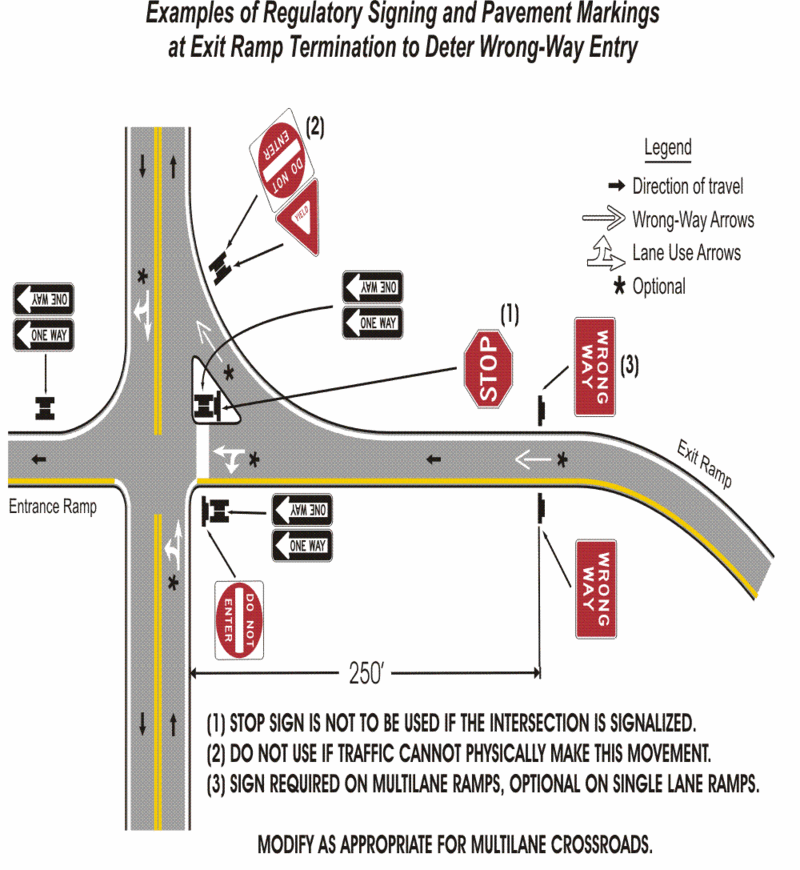
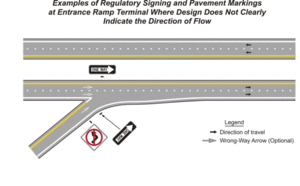
903.8.60 General Service Signs (MUTCD Section 2E.51)
 |
 |
|
 |
Standard. The use of general service (D9-25 and D9-26 series) signs (see EPG 903.7.49) shall only be provided in rural areas where the public would not expect to find required services or where there may be some doubt as to their availability.
General service signs shall only be used at interchanges. Such service signs shall be provided at all non-urban interchanges regardless of whether it is divided or a 2-lane, 2-way roadway.
Only the symbolic references to gas, food, lodging, camping, etc. (D9 series), shall be used. If the qualifying services are no longer present then the service signs shall be removed.
Option. If interchanges are not numbered, an action message such as NEXT EXIT or SECOND RIGHT may be used.
Standard. General Service signs shall have white symbols and borders on a blue background. Numeral sizes shall conform to the minimum requirements. If the services are not visible from the ramp of a single-exit interchange, the service signing shall be repeated in smaller size at the intersection of the exit ramp and the crossroad. Such service signs shall use arrows to indicate the direction to the services.
Guidance. Distance to services should be shown on General Service signs where distances are more than 1 mile.
General Service signing is only to be provided at locations where the traveler can return to the freeway or expressway and continue in the same direction of travel.
Standard. The specific requirements for each individual service shall be as follows:
A. Gas, Food and lodging if all of the following are available within sight at some point within the normal right of way limits of the interchange.
B. Propane and E-85 if all of the following are:
- 1.Located within 2 miles of the interchange;
- 2.Visible from the crossroad of the interchange; and
- 3. In continuous operations at least 16 hours per day, 7 days per week.
C. Camping if commercial campground is located with a 6-mile radius of the interchange.
D. Pharmacy if a pharmacy is open, with a state-licensed pharmacist on duty, 24 hours per day, 7 days per week and is located within 3 miles of an interchange on the federal-aid system.
For any service that is operated on a seasonal basis only, the General Service signs shall be removed or covered during periods when the service is not available.
The General Service signs shall be mounted in an effective location, between the Advance Guide sign and the Exit Direction sign, in advance of the exit leading to the available services.
If the distance to the next point where services are available is greater than 10 miles, a NEXT SERVICES XX MILES (D9-17) sign shall be used as a separate sign panel installed below the service sign.
Guidance. The General Service sign should contain the interchange number, if any.
When no qualifying services are available at any interchange the NO SERVICES AVAILABLE sign should be installed below the advance guide sign.
Standard. When new services become available or are changed, the department upon request shall change the signs to conform to the MoDOT general service sign policy. When a service is no longer available the appropriate service sign shall be removed.
Signs for services shall conform to the format for General Service signs (see EPG 903.8.46) and as specified herein. No more than six general traveler services shall be displayed on one sign, which includes any appended sign panels. General Service signs shall carry the legends for one or more of the following services: Gas, Food, Lodging, Camping, Propane, E85 or Pharmacy.
The qualified services available shall be shown at specific locations on the sign.
To provide flexibility for the future when the service might become available, the sign space normally reserved for a given service symbol or word shall be left blank when that service is not present.
Support. The background panels for these service symbols are D9-25 (1 service), D9-25a (2 services) and D9-25b (3 services). This is for locations where 1, 2, or 3 services are available.
A fully directional or clover leaf interchange having 1 to 5 services should have the D9-26 or D9-26a for independent use installed.
Guidance. Other interchanges having 4 services should use D9-26a.
When requisitioning the background panels, the specific service should be indicated per sign.
Option. The International Symbol of Accessibility for the Handicapped (D9-6) sign may be used for facilities that qualify.
Guidance. Symbols should be displayed as follows:
A. Six services:
- 1. Top row—GAS, FOOD, and LODGING
- 2. Bottom row—CAMPING, PROPANE, and E85 or PHARMACY
B. Four services:
- 1. Top row—GAS and FOOD
- 2. Bottom row—LODGING and CAMPING or PHARMACY
C. Three services: Top row—GAS, FOOD, and LODGING or PHARMACY
Option. Substitutions of other services for any of the services shown above may be made by placing the substitution in the lower right (four services or six services) or extreme right (three services) portion of the sign panel. An action message or an interchange number may be used for symbol signs in the same manner as they are used for word message signs. The Propane symbol or the E85 symbol may be substituted for the symbol representing fuel or appended to such assemblies. The Tourist Information (D9-10) symbol or Pharmacy (D9-20) may be substituted on any of the above configurations.
Standard. General service signs involving three or fewer services shall be provided on a panel below the advance guide sign. These signs shall be attached to the advance guide sign itself, not the signposts.
If more than three services become available at rural interchange areas where limited traveler services were anticipated, any appended sign panel shall be removed and replaced with an independently mounted General Service sign as described in this article.
A separate installation shall be maintained where four or more services are available.
Guidance. Separate general service sign installations should be maintained in an effective location between the advance guide sign and the exit direction sign in advance of the exit leading to the services available.
Option. The Recreational Vehicle Sanitary Station (D9-12) sign may be used as needed to indicate the availability of facilities designed for dumping wastes from recreational vehicle holding tanks.
903.8.61 Rest and Scenic Area Signs (MUTCD Section 2E.52)
 |
 |
Guidance. Signing for rest areas and scenic areas should conform to the provisions set forth in EPG 903.7.44 and EPG 903.7.46. Rest areas that have tourist information and welcome centers should be signed as discussed in EPG 903.8.62.
Scenic area signing should be consistent with that specified for rest areas. Standard messages should state SCENIC VIEW.
Standard. All signs for rest and scenic areas shall have white letters, symbols and borders on a blue background. Letter and numeral sizes shall conform to the minimum requirements. On the approach to rest areas, a REST AREA advance guide sign shall be placed 1 mile and/or 2 miles in advance of the rest area. At the rest area exit gore, there shall be a sign with a message REST AREA together with an arrow indicating the appropriate turn as shown.
903.8.62 Tourist Information and Welcome Center Signs (MUTCD Section 2E.53)
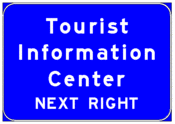 |
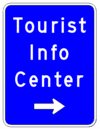 | |
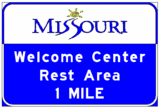 |
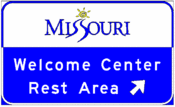 |
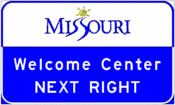 |
Standard. The Commission shall provide service signing for tourist information centers either privately or publicly owned which disseminate information to the motorists which would be beneficial to their travel in Missouri. The following criteria shall be used to determine eligibility for service signs for information centers:
1. All signing, on state highways, for the tourist information centers shall be located within a one mile radius of the tourist information center;
2. The tourist information center or space utilized should be a separate building or an area within a building adequate to house attendants and visitors. It shall be clean, well constructed and architecturally pleasing. Its intent shall not be to promote or enhance adjacent on-premise business activity;
3. Tourist information should a primary business activity conducted at the center;
4. The center shall be operated and staffed at least 8 hours a day, 7 days a week, during tourist season or provisions to provide information 7 days a week. If not operated during the winter, signs should be adequately modified;
5. The tourist information center shall dispense and display statewide, and regional information at no cost to the motorist; and
6. All privately owned tourist information centers shall be located off state right of way.
The service signing provided under the conditions of this policy shall contain the legend, TOURIST INFORMATION CENTER with appropriate directional arrow.
It is the intent of this policy to provide service signing for the above valid tourist information centers. Service stations, motels, cafes and other commercial activities that provide tourist information for promotional or incidental purposes, shall be excluded.
A maximum of two Tourist Information Center signs shall be provided on the state highway system for any tourist information center. Third order signing will be allowed. MoDOT shall provide signing for the Missouri Welcome Centers.
Guidance. Where Missouri Welcome Centers are located in rest areas the combination signs, Missouri Welcome Center / Rest Area sign, should be used in lieu of the rest area series of signing.
At other locations any existing tourist information signs should be replaced with the Missouri Welcome Center Signs.
Support. Tourist Information Centers operated only by the Missouri Division of Tourism are designated as Missouri Welcome Centers.
903.8.63 Missouri Welcome Center Affiliates (MUTCD Section 2E.53a)
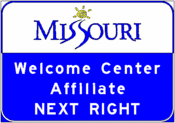 |
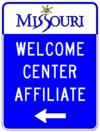 |
Support. The Missouri Division of Tourism has developed operational guidelines for Missouri Welcome Center Affiliates. This program is a means for local chamber/convention and visitor bureau’s and institutions of higher education with an established tourism curriculum to promote tourism and increase the number of welcome centers in Missouri without expending state funds. Any one interested in becoming a Missouri Welcome Center Affiliate should contact the Missouri Division of Tourism.
Standard. Upon written approval as a Missouri Welcome Center Affiliate by the Missouri Division of Tourism, the affiliate will request signing for the facility. The signing shall be paid for by the affiliate. A TR-15 contract shall be completed and payment received before ordering and installing the signs. The affiliates are recertified on a yearly basis, and if the affiliate fails to be recertified or losses the designation as an affiliate, the signs shall be removed.
A maximum of two interchange (D16-1) signs shall be provided on the state highway system for any welcome center affiliate. Third order signing shall be allowed.
903.8.64 Emergency Reference Markers (D10-5) (MUTCD Section 2E.54)
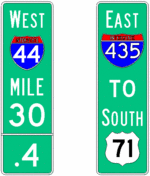
Support. Emergency Reference Marker (D10-5) signs enhance the reference location sign system by identifying the route. These signs are used to assist travelers in estimating their progress, provide a means for identifying the location of emergency incidents and traffic crashes, and to aid in highway maintenance and servicing.
Standard. Emergency Reference Markers (D10-5) signs, which enhance the reference location sign system by identifying the route and show the tenth of a mile with a decimal point, shall be placed on Interstates (instead of Reference Location signs) at two tenth of a mile intervals. An Emergency Reference Marker sign shall not be installed if it cannot be set within 200 ft. of its exact location.
Every attempt shall be made to install Emergency Reference Markers, even if this requires special mounting designs on walls, bridges or concrete median barrier.
If emergency reference markers are used, they shall be vertical panels having green backgrounds with white numerals, letters and borders, except for the route shield, which shall be the standard color and shape. The top line shall consist of the cardinal direction for the roadway. The second line shall consist of the applicable route shield for the roadway. The third line shall identify the mile reference for the location and the bottom line of the Emergency Reference Marker shall give the tenth of a mile reference for the location. The bottom line of the Emergency Reference Marker shall contain a decimal point.
The background color shall be the same for all intermediate enhanced reference location signs within a jurisdiction.
Emergency Reference Markers shall have a minimum mounting height of 4 ft. to the bottom of the sign according to the mounting height requirements of delineators (see Delineators in 620), and shall not be governed by the mounting height requirements prescribed in EPG 903.2.2.
The distance numbering shall be continuous for each route within the state, except where overlaps occur (see EPG 903.8.34). Where routes overlap, Emergency Reference Marker continuity shall be established for only one of the routes. If one of the overlapping routes is an Interstate route, that route shall be selected for continuity of distance numbering.
The distance measurement shall be made on the northbound and eastbound roadways. Emergency Reference Markers for southbound or westbound roadways shall be set at locations directly opposite the enhanced reference location signs for the northbound or eastbound roadways.
Guidance. The route selected for continuity of distance numbering should also have continuity in interchange exit numbering (see EPG 903.8.34). On a route without Emergency Reference Marker continuity, the first Emergency Reference Marker beyond the overlap should indicate the total distance traveled on the route so that travelers will have a means of correlating their travel distance between Emergency Reference Markers with that shown on their odometer.
Standard. Except as provided in the option below Emergency Reference Markers shall be installed on the right side of the roadway.
Option. Where conditions limit or restrict the use of enhanced reference location signs on the right side of the roadway, they may be installed in the median. In urban areas, Emergency Reference Markers may be installed on the right side of the roadway, in the median, or on ramps to replace or to supplement the reference location signs. Emergency Reference Markers may be installed back-to-back in median locations.
903.8.65 Miscellaneous Guide Signs (MUTCD Section 2E.55)
Support. Miscellaneous Guide signs are used to point out geographical features, such as rivers and summits and other jurisdictional boundaries (see General Information Signs, I Series).
Option. Miscellaneous Guide signs may be used if they do not interfere with signing for interchanges or other critical points.
Guidance. Miscellaneous Guide signs are not to be installed unless there are specific reasons for orienting the travelers or identifying control points for activities that are clearly in the public interest. If Miscellaneous Guide signs should be of value to the traveler, they should be consistent with other freeway or expressway guide signs in design and legibility. On all such signs, the design should be simple and dignified, without any tendency toward flamboyant advertising and in general conformance with other freeway and expressway signing.
903.8.66 Carpool and Ridesharing Signing (MUTCD Section 2E.57)
 |
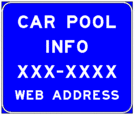 |
 |
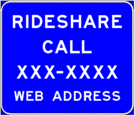 |
Option. In those communities where the Department of Natural Resources facilitates this program, Carpool Information (D12-2, D12-2a, D12-2b and D12-2c) signs may be provided adjacent to highways with preferential lanes or along any other highway.
Carpool Information signs may include Internet addresses or telephone numbers of more than four characters within the legend.
Guidance. Because this is an information sign related to traveler services, the Carpool Information sign should have a white legend and border on a blue background.
Standard. If a local transit logo or carpool symbol is incorporated into the Carpool Information sign, the maximum vertical dimension of the logo or symbol shall not exceed 18 in.
903.8.67 Weigh Station Signing (MUTCD Section 2E.58)
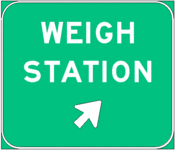
Standard. Weigh Station signing on freeways and expressways shall be the same as that specified in Weigh Station Signing except for lettering size and the advance posting distance for the Exit Direction (D8-3) sign, which shall be located a minimum of 1,500 ft. in advance of the gore.
Support. Weigh Station sign layouts for freeway and expressway applications are shown in Standard Highway Signs (see EPG 903.19.11).
903.8.68 PREFERENTIAL ONLY LANES
Support. Not used in Missouri.






